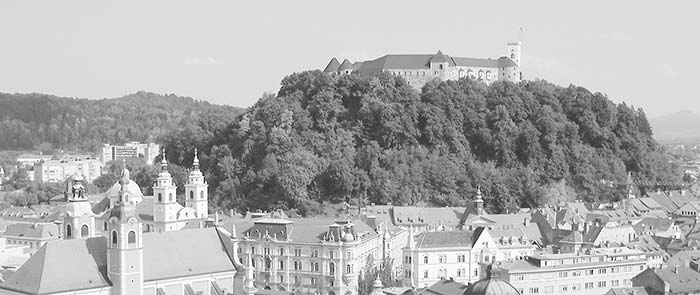
Map: Ljubljana Hotels & Restaurants
AT CIRIL-METODOV TRG AND NEAR THE MARKET
GETTING TO CROATIA’S ISTRIAN PENINSULA
Ljubljana (lyoob-lyee-AH-nah) is irresistible. With a lazy Old Town clustered around a castle-topped hill, Slovenia’s capital is often likened to Salzburg. It’s an apt comparison—but only if you inject a healthy dose of breezy Adriatic culture, add a Slavic accent, and replace favorite son Mozart with local architect Jože Plečnik.
Ljubljana feels smaller than its population of 270,000. With several clusters of good museums that try hard—but have only so much to say—it does its best to please sightseers. But ultimately, this town is all about ambience. The cobbled core of Ljubljana is an idyllic place that sometimes feels too good to be true. The cityscape is slathered with one-of-a-kind architecture, festivals fill the summer, and people enjoy a Sunday stroll any day of the week. Fashion boutiques and al fresco cafés jockey for control of the Old Town, while the leafy riverside promenade crawls with stylishly dressed students sipping kava and polishing their near-perfect English. Laid-back Ljubljana is the kind of place where graffiti and crumbling buildings seem elegantly atmospheric instead of shoddy. But more and more of those buildings have been getting a facelift recently, as a spunky mayor has been spiffing up the place and creating gleaming traffic-free zones left and right—making what was already an exceptionally livable city into a true pedestrians’ paradise.
Batted around by history, Ljubljana has seen cultural influences from all sides—most notably Prague, Vienna, and Venice. This has left the city a happy hodgepodge of cultures. Being the midpoint between the Slavic, Germanic, and Italian worlds gives Ljubljana a special spice.
Ljubljana deserves at least a full day. Rather than checking off a list of museums, spend most of your time strolling the pleasant town center, exploring the many interesting squares and architectural gems, browsing the produce market, shopping at the boutiques, and sipping coffee at sidewalk cafés along the river.
Here’s the best plan for a low-impact sightseeing day: Begin on Prešeren Square, the heart of the city. Cross the Triple Bridge and wander through the riverside produce market before joining the town walking tour at 10:00 (at 11:00 in Oct-March). Then wander south along the Ljubljanica River and through the Krakovo gardens to tour the Jože Plečnik House (closed Mon). In the afternoon, commit some quality time to people-watching at a riverside café, window-shop at some colorful boutiques (perhaps following my self-guided shopping walk in the Old Town), or do more sightseeing (good options include the City History Museum, near several Jože Plečnik landmarks downtown; the Serbian Orthodox Church and Tivoli Park, with the Contemporary History Museum, west of downtown; or the Slovenian Ethnographic Museum and other sights in Metelkova, north of downtown).
Ljubljana is sleepy on Sundays (virtually all shops are closed and the produce market is quiet, but museums are generally open, a modest flea market stretches along the riverfront, and the TI’s walking tour still runs). The city is also relatively quiet in August, when the students are on break and many locals head to beach resorts. They say that in August, even homeless people go to the coast.
Ljubljana’s central zone is compact, and with a little wandering, you’ll quickly get the hang of it. The Ljubljanica River—lined with cafés, restaurants, and a buzzing outdoor market—bisects the city, making a 90-degree turn around the base of a castle-topped hill. Most sights are either along or just a short walk from the river. Visitors enjoy the distinctive bridges that span the Ljubljanica, including the landmark Triple Bridge (Tromostovje) and pillared Cobblers’ Bridge (Čevljarski Most)—both designed by Jože Plečnik. Between these two is a plain bridge (with great views) called Brv (roughly, “simple footbridge”). The center of Ljubljana is Prešeren Square, watched over by a big statue of Slovenia’s national poet, France Prešeren.
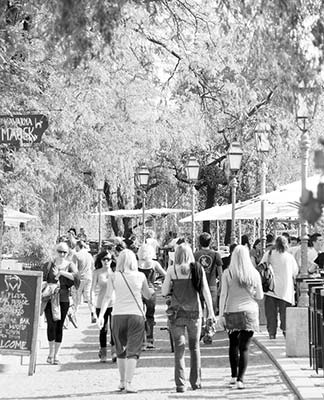
I’ve organized the sights in this chapter based on which side of the river they’re on: the east (castle) side of the river, which is where Ljubljana began and has more medieval charm; and the west (Prešeren Square) side of the river, which has a more Baroque/Art Nouveau feel and most of the urban sprawl. At the northern edge of the tourist’s Ljubljana is the train station and Metelkova museum and nightlife zone; at the southern edge are the garden district of Krakovo and the Jože Plečnik House; and at the western edge is Tivoli Park.
Ljubljana’s Two Big Ps: You’ll hear the following two easy-to-confuse names constantly during your visit. Mind your Ps, and your visit to Ljubljana becomes more meaningful: Jože Plečnik (YOH-zheh PLAYCH-neek, 1872-1957) is the architect who shaped Ljubljana, designing virtually all of the city’s most important landmarks. For more information, see here. France Prešeren (FRAHN-tseh preh-SHAY-rehn, 1800-1849) is Slovenia’s greatest poet and the namesake of Ljubljana’s main square.
Ljubljana’s helpful, businesslike TI has a useful website (www.visitljubljana.com) and two branches: at the Triple Bridge, across from Prešeren Square (daily June-Sept 8:00-21:00, Oct-May until 19:00, Stritarjeva 1, tel. 01/306-1215); and at the upper corner of the market (with bikes to rent and information about the rest of Slovenia; June-Sept daily 8:00-21:00; Oct-May Mon-Fri 8:00-19:00, Sat-Sun 9:00-17:00; Krekov trg 10, tel. 01/306-4575). At either TI, pick up a pile of free resources, including the big city map, the Tourist Guide, and the monthly events guide.
The Ljubljana Tourist Card, which includes access to public transportation and covers entry to many city museums as well as the TIs’ walking tours and boat trips, could save busy sightseers some money (€23/24 hours, €30/48 hours, €35/72 hours).
By Train: Ljubljana’s modern, user-friendly train station (Železniška Postaja) is at the northern edge of the city center. Emerging from the passage up to track 1a, turn right and walk under the long canopy to find the yellow arrivals hall. Everything is well-signed in English, including the handy train-information office (with useful handouts outlining journeys to several domestic and international destinations), lockers, and—near the front of the station—a big ticket office with clearly marked ticket windows and an ATM. Arrivals are prihodi, departures are odhodi, and track is tir.
You can walk to any of my recommended hotels within about 20 minutes (often less). To reach Prešeren Square at the city’s center, leave the arrivals hall to the right and walk a long block along the busy Trg Osvobodilne Fronte (or “Trg O.F.” for short, with the bus station in the middle). After passing the bus stalls, turn left across Trg O.F. and go down Miklošičeva, at the building with the round, red-brick columns. This takes you past some of Ljubljana’s most appealing architecture to Prešeren Square.
Unscrupulous taxis crouch in front of the station, waiting to spring on unsuspecting tourists. The fair metered rate to any of my recommended hotels is around €3 (maybe up to €4-5 in heavy traffic or after hours). But, because the city refuses to regulate taxi tariffs, train-station taxis uniformly charge exorbitant rates—generally around €3-5 per kilometer (plus an extra fee of around €2-3 for bags). Simply put, it’s impossible to hail a taxi on the street in front of the station and get anything resembling a fair fare. To avoid giving these crooks the satisfaction, call for a taxi that charges fair rates (tel. 080-1190, 01/511-2314, or 01/520-9704). Taking just a few more minutes to wait for your cab could easily save you €10 or more. For more on taxis—and how to avoid rip-offs—see “Getting Around Ljubljana—By Taxi,” later.
By Bus: Ljubljana’s bus station (Autobusna Postaja) is a low-profile building (with ticket windows, a bakery, and newsstands) in the middle of Trg O.F., right in front of the train station. To get into the city center, see “By Train,” earlier.
By Car: As you approach Ljubljana on the expressway, the toll road ends. Once you’re on the ring road, simply follow signs for Center. Once you get into the city center, you’ll begin to see directional signs to individual hotels.
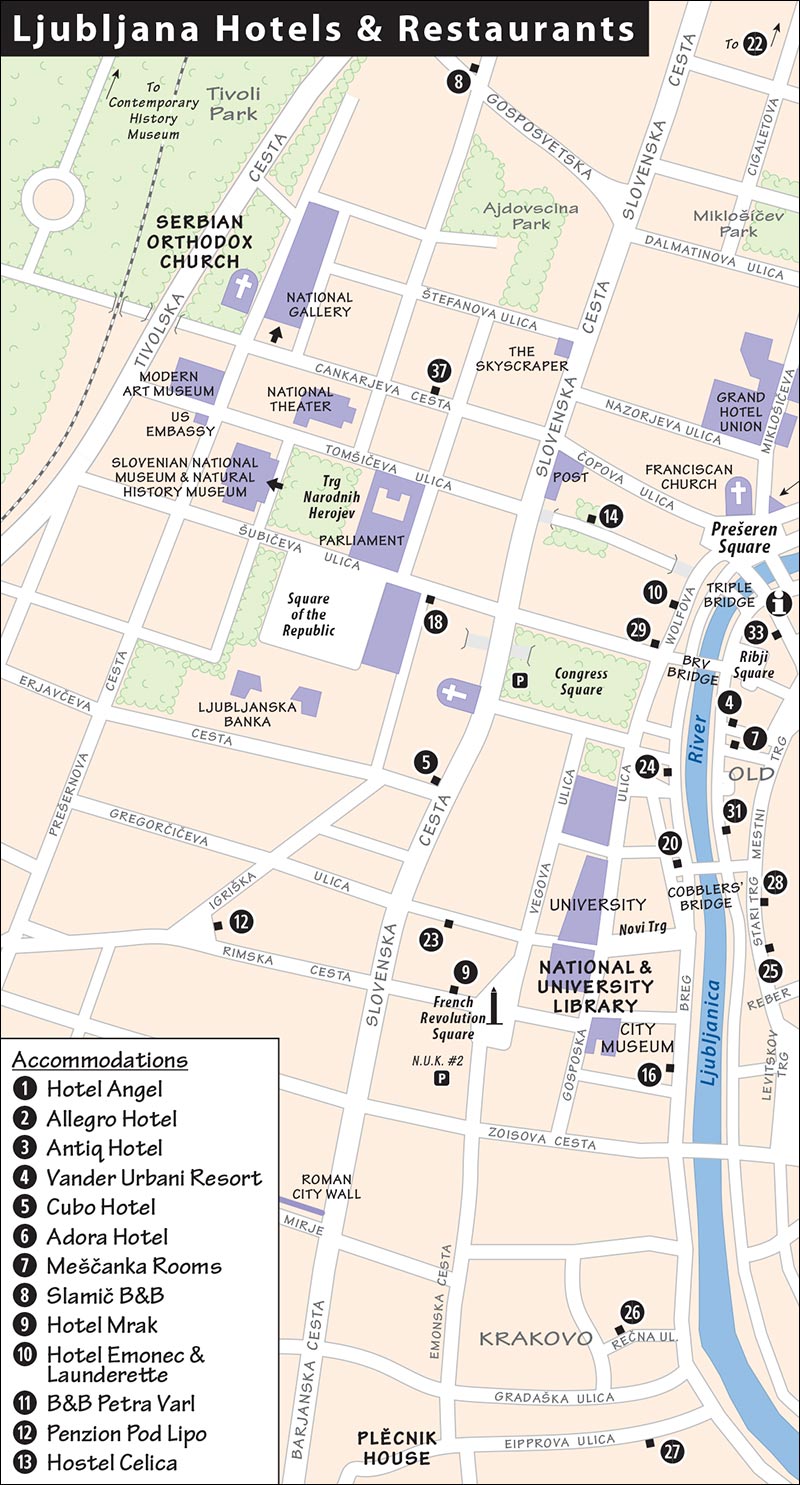


Ljubljana is not car-friendly; much of the central zone along the river is entirely traffic-free. Even several blocks of the main thoroughfare, Slovenska cesta—north of Congress Square, between Šubičeva ulica and Gosposvetska cesta—are closed to all traffic except buses. To reach the southern part of the city when entering downtown from the north, you need to circumnavigate the core by looping east along Resljeva cesta, over the Dragon Bridge by the market, and through the tunnel beneath the castle; from here, Karlovška cesta cuts back west over the river to the southern stretch of Slovenska cesta.
Ask your hotel about parking—most have some available, usually for a price. Two particularly central (and expensive) parking lots are the one beneath Congress Square (€1.20/hour for first 3 hours, then €2.40/hour, or €1.80/hour overnight) and the one called N.U.K. #2, near the National and University Library (€1.20/hour 7:00-19:00, €1.80/hour overnight). Both of these lots are accessible on Slovenska cesta only from the south—if coming from the north, see directions above. Another handy lot is Kapitelj, just southeast of the Dragon Bridge (€1.90/first hour, then €2.40/hour, or €1.50/hour 18:00-6:00). Legal, paid parking downtown is marked by blue lines (look for meters); these spaces are free Saturdays after 13:00 and all day Sunday.
If you need to gas up your rental car before returning it here, you’ll find a huge gas station on Tivolska cesta (just west of the train station, near the big Union brewery).
By Plane: See “Ljubljana Connections,” at the end of this chapter.
Exchange Rate: €1 = about $1.10
Country Calling Code: 386 (see here for dialing instructions).
Pedestrian Safety: Many Ljubljana residents commute by bike—and they’re not shy about whizzing past pedestrians. Keep your eyes open and stay out of the designated bike lanes on the sidewalks (often marked in red).
Closed Days: Most Ljubljana museums (except the castle and a few less-important museums) are closed on Mondays.
Markets: In addition to the regular market that sprawls along the riverfront (described under “Sights in Ljubljana”), a colorful flea market hops along the Ljubljanica River’s Breg embankment (across the river from the castle) every Sun 8:00-14:00. On summer Saturdays, there’s also a lively and colorful arts and handicrafts market in the same place (Sat 8:00-14:00).
Wi-Fi: The city’s WiFree program—with Wi-Fi hotspots near Prešeren Square and along the river—lets you get online free for up to an hour. Pick up the brochure at the TI (you’ll be texted a code to enter).
Post Office: The main post office (pošta) is in a beautiful yellow Art Nouveau building a block up Čopova from Prešeren Square, at the intersection with Slovenska cesta (Mon-Fri 8:00-19:00, Sat 8:00-12:00, closed Sun).
Laundry: The handiest option is Emonec Launderette, with self-service machines across the courtyard from the couldn’t-be-more-central Hotel Emonec (described on here); this is a convenient spot to tumble-dry your undies while exploring (€5/load wash and dry, daily 6:00-20:00, Wolfova 12, tel. 01/200-1520). Hostel Celica also has self-service laundry—but it has only one machine, and hostel guests have priority (€8/load, not very central at Metelkova 8). For pricey full service, try Tekstilexpress, between the city center and Tivoli Park (€4.80/kilo, figure about €20-25 for a full load, takes 24 hours, Mon-Fri 7:00-19:00, Sat 9:00-13:00, closed Sun, Cankarjeva 10B, tel. 01/252-7354).
Car Rental: Handy options include Hertz (Trdinova 9, tel. 01/434-0147, www.hertz.si), Europcar (in City Hotel at Dalmatinova 15, mobile 031-382-052, www.europcar.si), Avis and Budget (both in Grand Hotel Union at Miklošičeva 3; Avis—tel. 01/241-7340, www.avis.si; Budget—tel. 01/421-7340, www.budget.si), and Sixt (at the train station, tel. 01/234-4650).
Best Views: The Skyscraper’s observation deck offers the best views in town (see here). Views from the castle are nearly as good. At street level, my favorite views are from the bridge called Brv (between the Triple and Cobblers’ bridges), especially at night. On sunny days, the colorful architecture on and near Prešeren Square pops, and you’ll take photos like crazy along the river promenade.
By Bus: Virtually all of Ljubljana’s sights are easily accessible by foot. And using the buses is a bit of a headache: First, you have to buy a plastic “Urbana” card for €2, which you then load with credit to pay for rides (you can’t pay the driver). A ride costs €1.20 (valid for up to 90 minutes, card shareable by up to three people). Buy the card at the TI, where you can return it to reclaim your €2 at the end of your trip. Transit info: www.lpp.si.
By Taxi: Always call for a cab, or you’ll get ripped off. Because cabbies can legally charge whatever they want, even if they use the meter you’ll still pay way too much. Legitimate taxis usually start at about €1.50, and then charge €1 per kilometer. But because city leaders refuse to regulate taxi tariffs, many unscrupulous cabbies (including all of those who wait at the train station) legally charge far more, and tack on bogus additional “surcharges.” Crooked cabbies are a big problem in Ljubljana, but you can avoid this headache entirely by always calling a reputable taxi company instead of hailing one on the street. If you do this, Ljubljana is a fantastic taxi town with very affordable rates—a ride within the city center (such as from the station to a hotel) should run only a few euros, generally less than €5. Good companies include Metro Taxi (tel. 080-1190 or 041-240-200), Laguna (tel. 01/511-2314), or Intertours (tel. 01/520-9704). Don’t be intimidated—dispatchers speak English, and your hotel, restaurant, or the TI can call a cab for you.
By Bike: Ljubljana is a cyclist’s delight, with lots of well-marked bike lanes. It’s easiest to rent bikes at the market square TI (€2/2 hours, €8/day; see “Tourist Information,” earlier). Like many European cities, Ljubljana has a subsidized borrow-a-bike program (called BicikeLJ) with 30 locations around the city center. Once you register online with a credit card (€1 fee for a weekly subscription), rides are free or very cheap (free for the first hour, €1 for the second, €2 for the third, and so on). If you’re planning on doing lots of biking, it’s worth the hassle to sign up (http://en.bicikelj.si).
By Shuttle Bus: After Ljubljana pedestrianized much of its downtown core a few years back, the natives began to squawk about the hassle of getting around without a car. To mollify critics, the city subsidizes a network of green electric carts, called Kavalir, which anyone (even tourists) can flag down or call to take them anywhere within the pedestrian zone...for free. Just wave one down and tell them where you want to go (or phone them—April-Oct call 031-666-331 or 031-666-332; Nov-March call 031-666-299).
To help you appreciate Ljubljana, taking a walking tour—either through the TI or by hiring your own local guide—is worth ▲▲.
The TI organizes excellent two-hour guided town walks of Ljubljana in English, led by knowledgeable guides. In summer, the walk also includes either a trip up to the castle (by funicular or tourist train) or a 30-minute boat ride on the river. From April through September, there are three tours daily at 10:00, 14:00, and 17:00. From October through March, the walking tour goes daily at 11:00 (€10, or €9 if you pay at TI, meet at Town Hall around corner from Triple Bridge TI). They also offer a variety of other tours, including a food tour, a torchlight tour of Roman ruins, a Town Hall tour, and so on—get details at the TI.
Having an expert show you around his or her hometown for two hours for €70 has to be the best value in town. Marijan Krišković, who leads tours for me throughout Europe, is an outstanding guide (mobile 040-222-739, kriskovic@yahoo.com). Barbara Jakopič, thoughtful and extremely knowledgeable, also leads my tours (mobile 040-530-870, b_lucky2@yahoo.com). Minka Kahrič, who’s traveled to the North Pole, also leads tours closer to home—including walks around Ljubljana and excursions into the countryside (€70/2-hour walking tour; driving: €100/up to 4 hours, €140/up to 8 hours; mobile 041-805-962, polarnimedo@yahoo.com). You can also book a guide through the TI (arrange at least 24 hours in advance).
Because Ljubljana is a small town that’s easily seen on foot, a boat trip on the Ljubljanica River is more romantic than informative. You have two options for your one-hour cruise (weather permitting): with English commentary from a live guide (€10, 2/day in summer, departs from near the Triple Bridge—about one block along the embankment away from the market, get details from TI), or unguided (€8, may have audioguides, 2-3/hour in summer 10:00-20:00, operated by various companies and from various docks—they’ll approach you as you walk past).
Many worthwhile sights near Ljubljana are tricky to reach by public transportation. To hit several efficiently in one day, join an excursion. Three relatively well-established outfits are Roundabout (their one-day “Karst and Coast Mystery” tour takes you to Predjama Castle, Škocjan Caves, Lipica, and Piran for €49 plus admission to the caves and an optional wine tasting; www.roundabout.si; their “off the beaten track” tours delve deeper into local culture), Slovenia Explorer (their ambitious “Slovenia in 1 Day” trip visits Lake Bled, Postojna Caves, and Predjama Castle for €119; www.slovenia-explorer.com), and Nature Adventures (focused on active trips including rafting, paragliding, skydiving, and horseback riding; www.adventures-nature.com). For multiday trips around the country, check out the Loopyslovenia hop-on, hop-off bus service (www.loopyslovenia.com).
The heart of Ljubljana is the people-friendly, traffic-free Prešeren Square (Prešernov trg, rated ▲▲), which is described in this self-guided spin tour.
The city’s meeting point is the large statue of France Prešeren, Slovenia’s greatest poet, whose works include the lyrics to the Slovenian national anthem (and whose silhouette adorns Slovenia’s €2 coin). The statue shows Prešeren, an important catalyst of 19th-century Slovenian nationalism, being inspired from above by a Muse. This statue provoked a scandal and outraged the bishop when it went up a century ago—a naked woman sharing the square with a church! To ensure that nobody could be confused about the woman’s intentions, she’s conspicuously depicted with typical Muse accessories: a laurel branch and a cloak. Even so, for the first few years citizens covered the scandalous statue with a tarp each night. And the model who posed for the Muse was so disgraced that no one in Slovenia would hire her—so she emigrated to South America and never returned.
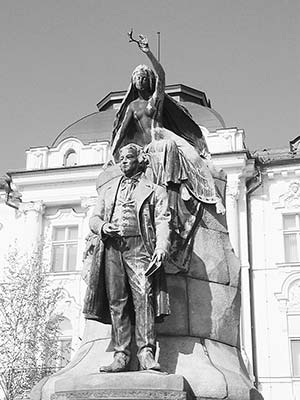
Stand at the base of the statue to get oriented. The bridge crossing the Ljubljanica River is one of Ljubljana’s top landmarks, Jože Plečnik’s Triple Bridge (Tromostovje). The middle (widest) part of this bridge already existed, but Plečnik added the two side spans to more efficiently funnel the six streets of traffic on this side of the bridge to the one street on the other side. The bridge’s Venetian vibe is intentional: Plečnik recognized that Ljubljana, located midway between Venice and then-capital Vienna, is itself a bridge between the Italian and Germanic worlds. Across the bridge are the TI, WCs, ATMs, market and cathedral (to the left), and the Town Hall (straight ahead).
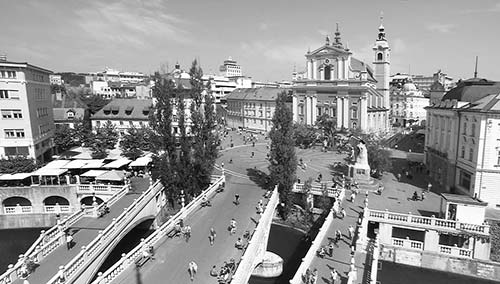
Now turn 90 degrees to the right, and look down the first street after the riverbank. Find the rose-colored woman in the picture frame on the second floor of the first yellow house. This is Julija, the unrequited love of Prešeren’s life. Tour guides spin romantic tales about how the couple met. But the truth is far less exciting: He was a teacher in her father’s house when he was in his 30s and she was 4. Later in life, she inspired him from afar—as she does now, from across the square—but they never got together. She may have been his muse, but when it came to marriage, she opted for wealth and status.
When Ljubljana was hit by an earthquake in 1895, locals took the opportunity (using an ample rebuilding fund from the Austro-Hungarian Empire) to remake their city in style. Today Ljubljana—especially the streets around this square—is an architecture-lover’s paradise. The Hauptmann House, to the right of Julija, was the only building on the square to survive the quake. A few years later, the owner redecorated it in the then-trendy Viennese Art Nouveau style you see today, using bright colors (since his family sold dyes). All that remains of the original structure is the little Baroque balcony above the entrance.
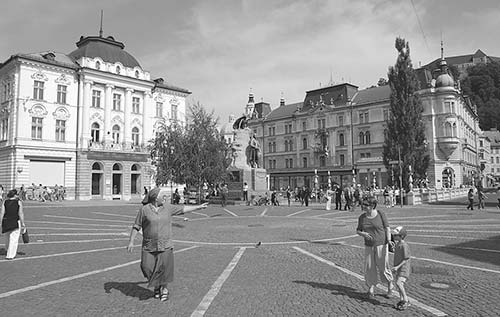
Just to the right of the Hauptmann House is a car-sized model of the city center—helpful for orientation. The street next to it (with the McDonald’s) is Čopova, once the route of Ljubljana’s Sunday promenade. A century ago, locals would put on their Sunday best and stroll from here to Tivoli Park, listening to musicians and dropping into cafés along the way. Plečnik called it the “lifeline of the city,” connecting the green lungs of the park to this urban center. Through the 20th century, this route became less pedestrian-friendly, as Slovenska cesta and railroad tracks were both laid across it. Things are getting better with the closure of Slovenska to all traffic except buses, but Ljubljana’s best evening paseo thrives along the river from the Triple Bridge all the way up the river.
Continue looking to the right, past the big, pink landmark Franciscan Church of St. Mary. Next door, the characteristic glass awning marks Galerija Emporium—the first big post-quake department store, today government-protected. At the top of the building is Mercury, god of commerce, watching over the square that has been Ljubljana’s commercial heart since the city began. (If you look carefully, you can see the mustachioed face of the building’s owner hiding in the folds of cloth by Mercury’s left foot.) Since this area was across the river from medieval Ljubljana (beyond the town’s limits...and the long arm of its tax collector), it was the best place to buy and sell goods. Today this sumptuously restored building houses a top-end fashion mall, making it the heart of Ljubljana’s boutique culture. Step inside for a glimpse at the grand staircase.
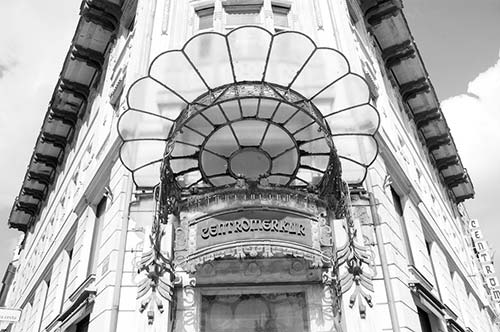
The street between Galerija Emporium and the pink church is Miklošičeva cesta, which connects Prešeren Square to the train station. When Ljubljana was rebuilding after the 1895 earthquake, town architects and designers envisioned this street as a showcase of its new, Vienna-inspired Art Nouveau image.
Up Miklošičeva cesta and on the left is the prominent Grand Hotel Union, with a stately domed spire on the corner. When these buildings were designed, Prague was the cultural capital of the Slavic world. The new look of Ljubljana paid homage to “the golden city of a hundred spires” (and copied Prague’s romantic image). The city actually had a law for several years that new corner buildings had to have these spires. Even the trees you’ll see around town were part of the vision. When the architect Plečnik designed the Ljubljanica River embankments a generation later, he planted tall, pointy poplar trees and squat, rounded willows—imitating the spires and domes of Prague.
Detour a block up Miklošičeva cesta to see two more architectural gems of that era (across from the Grand Hotel Union): First is a Secessionist building—marked Zadružna Zveza—with classic red, blue, and white colors (for the Slovenian flag). Next is the noisy, pink, zigzagged Cooperative Bank. The bank was designed by Ivan Vurnik, an ambitious Slovenian architect who wanted to invent a distinctive national style after World War I, when the Habsburg Empire broke up and Eastern Europe’s nations were proudly emerging for the first time.
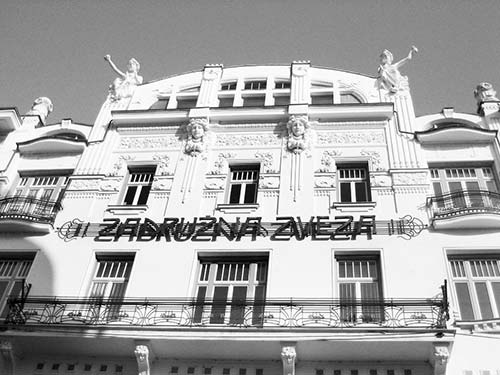
Prešeren Square is the perfect springboard to explore the rest of Ljubljana. Now that you’re oriented, visit some of the areas listed next.
▲Town Square (Mestni Trg) and the Old Town
▲Ljubljana Castle (Ljubljanski Grad)
THE MUSEUM ZONE AND TIVOLI PARK
Congress Square (Kongresni Trg)
▲Square of the Republic (Trg Republike)
Slovenian National Museum (Narodni Muzej Slovenije) and Slovenian Museum of Natural History (Prirodoslovni Muzej Slovenije)
National Gallery (Narodna Galerija)
Museum of Modern Art (Moderna Galerija Ljubljana)
▲▲Serbian Orthodox Church of Sts. Cyril and Methodius
▲Contemporary History Musuem (Muzej Novejše Zgodovine)
▲City Museum of Ljubljana (Mestni Muzej Ljubljana)
▲Cobblers’ Bridge (Čevljarski Most)
▲▲National and University Library (Narodna in Univerzitetna Knjižnica, or NUK)
French Revolution Square (Trg Francoske Revolucije)
▲▲Jože Plečnik House (Plečnikova Zbirka)
▲▲Slovenian Ethnographic Museum (Slovenski Etnografski Muzej)
Slovenian National Museum-Metelkova (Narodni Muzej Slovenije)
Museum of Contemporary Art-Metelkova (Muzej Sodobne Umetnosti Metelkova, MSUM)
Metelkova City (Metelkova Mesto)
Ljubljana is bursting with well-presented, we-try-harder museums celebrating Slovenian history and culture. These include the Slovenian History Exhibition at the castle, the City Museum of Ljubljana, and the Contemporary History Museum in Tivoli Park. As these are similar and largely overlapping, if you get museumed-out easily, just pick the one that’s handiest to your sightseeing plan.
The castle (east) side of the river is the city’s most colorful and historic quarter, packed with Old World ambience.
In Ljubljana’s thriving Old Town market, big-city Slovenes enjoy buying directly from the producer. Prices go down as the day gets late and as the week goes on. The market, worth an amble anytime, is best on Saturday mornings, when the townspeople take their time wandering the stalls. In this tiny capital of a tiny country, you may even see the president searching for the perfect melon.
 Self-Guided Walk: Begin your walk through the market at the Triple Bridge (and TI). The riverside colonnade, which echoes the long-gone medieval city wall, was designed by (who else?) Jože Plečnik. This first stretch—nearest the Triple Bridge—is good for souvenirs: woodcarvings, replica painted frontboards from beehives, honey products (including honey brandy), and lots of colorful candles (bubbly Marta will gladly paint a special message on your candle for no extra charge). For lots more shopping tips—here and nearby—see “Shopping in Ljubljana,” later.
Self-Guided Walk: Begin your walk through the market at the Triple Bridge (and TI). The riverside colonnade, which echoes the long-gone medieval city wall, was designed by (who else?) Jože Plečnik. This first stretch—nearest the Triple Bridge—is good for souvenirs: woodcarvings, replica painted frontboards from beehives, honey products (including honey brandy), and lots of colorful candles (bubbly Marta will gladly paint a special message on your candle for no extra charge). For lots more shopping tips—here and nearby—see “Shopping in Ljubljana,” later.
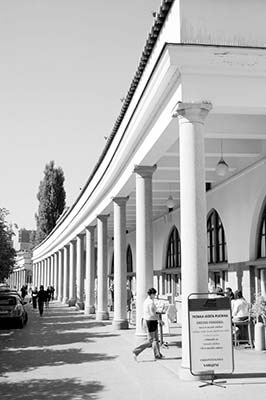
Farther in, the market is almost all local, and the colonnade is populated by butchers, bakers, fishermen, and lazy cafés. Peek down at the actual river and see how the architect wanted the town and river to connect. The lower arcade (which you can access directly from the Triple Bridge or by going down the spiral staircase by the beehive panels) is a people zone, with public WCs, inviting cafés, and a stinky fish market (ribarnica) offering a wide variety. The recommended restaurant just below, Ribca, serves fun fishy plates, beer, and coffee with great riverside seating.
Across from the stairs that lead down into the fish market, about where the souvenir stands end, you reach the first small market square. On your right, notice the 10-foot-tall concrete cone. Plečnik wanted to make Ljubljana the “Athens of the North” and imagined a huge cone-shaped national acropolis—a complex for government, museums, and culture. This ambitious plan didn’t make it off the drawing board, but part of Plečnik’s Greek idea came true: this marketplace, based on an ancient Greek agora. Plečnik’s cone still captures the Slovenes’ imaginations...and adorns Slovenia’s €0.10 coin.
At the top of this square, you’ll find the 18th-century cathedral standing on the site of a 13th-century Romanesque church (check out its finely decorated doors—and, if they’re open, go inside; for a complete description, see later).
The building at the end of the first market square is the seminary palace. In the basement is a market hall (pokrita tržnica), with vendors selling cheeses, meats, baked goods, dried fruits, nuts, and other goodies (Mon-Fri 7:00-16:00, Sat 7:00-14:00, closed Sun). This place is worth a graze—walk all the way through. Most merchants are happy to give you a free sample (point to what you want, and say probat, prosim—“a taste, please”).
Leaving the market hall at the opposite end, turn left to reach the modern Butchers’ Bridge. Jože Plečnik designed a huge roofed bridge to be built here, but—like so many of his designs—the plans were scuttled. Decades later, aware of Plečnik’s newfound touristic currency, some town politicians dusted off the old plans and proposed building the bridge. The project stalled for years until the arrival of Mayor Zoran Janković, who swiftly constructed this modern version of the bridge. While it looks nothing like Plečnik’s original plans, the bridge kept the old name and has been embraced by the community (there’s a handy public WC down below on the lower level). The sculptures on the bridge, by local artist Jakov Brdar, were originally intended to be temporary—but people loved them, so they stayed. (The wild-eyed, wild-bearded Brdar often hangs out near the bridge, asking passersby how they like his creations.) Notice the mournful pose of the Adam and Eve statues (being evicted from the Garden of Eden) at the market end of the bridge. And don’t miss the bizarre smaller sculptures along the railing—such as the ones that look like mischievous lizards breaking out of their eggs. Almost as soon as it was built, the bridge’s railings were covered with padlocks—part of the recent Europe-wide craze for young couples to commemorate their love by locking a padlock to a bridge railing. But all those locks put too much strain on the railing—they are regularly cut off, soon to be replaced by new ones.
Sprawling up from the bridge is the main market square, packed with produce and clothing stands. (The colorful flower market hides behind the market hall.) The vendors in the row nearest the colonnade sell fruit from all over, but the ones located deeper in the market sell only locally-grown produce. These producers go out of their way to be old-fashioned—a few of them still follow the tradition of pushing their veggies on wooden carts (called cizas) to the market from their garden patches in the suburbs. Once at the market, they simply display their goods on top of their cart, turning it into a sales kiosk. Tell the vendor what you want—it’s considered rude for customers to touch the fruits and vegetables before they’re bought. Over time, shoppers develop friendships with their favorite producers. On busy days, you’ll see a long line at one stand, while the other merchants stand bored. Your choice is simple: Get in line, or eat subpar produce.
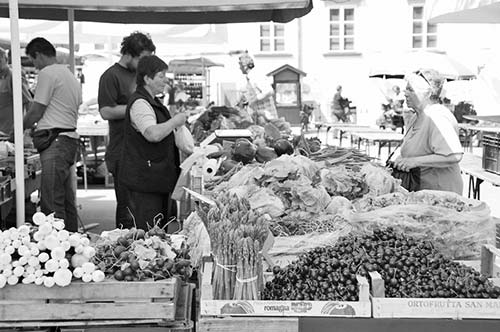
Near the market hall, look for the little scales in the wooden kiosks marked Kontrolna Tehtnica—allowing buyers to immediately check whether the producer cheated them (not a common problem, but just in case). The Habsburg days left locals with the old German saying, “Trust is good; control is better.” Nearby, look for the innovative “Nonstop Mlekomat” stand, a vending machine that lets you buy a plastic bottle, then fill it with a liter of raw, unskimmed, farm-fresh milk for €1.
At the far end of the market—close to the Dragon Bridge—you may see a few food trucks selling roasted chicken and deep-fried seafood.
Two more sights are immersed in the market action (both described next); the cathedral sits at the top of the market area, near the Triple Bridge, while the Dragon Bridge spans the river just beyond the end of the market colonnade.
Ljubljana’s cathedral is dedicated to St. Nicholas, protector against floods and patron saint of the fishermen and boatmen who have long come to sell their catch at the market. While the interior is worth a peek, the intricately decorated doors—created for Pope John Paul II’s visit here in 1996—are even more interesting.
Cost and Hours: Free, open long hours daily but closed 12:00-15:00.
Visiting the Cathedral: Begin outside, at the top of the small market square. Go under the high arch and take a close look at the cathedral’s remarkable main door. Buried deeply in the fecund soil of the nation’s ancient and pagan history, the linden tree of life sprouts with the story of the Slovenes. The ceramic pots represent the original Roman settlement here. Just to the left, above the tree, are the Byzantine missionaries Cyril and Methodius, who came here to convert the Slavs to Christianity in the ninth century. Just above, Crusaders and Ottomans do battle. Near the top, see the Slovenes going into the cave—entering the dark 20th century (World War I, World War II, and communism). At the top is Pope John Paul II (the first Slavic pontiff, who also oversaw the fall of communism). Below him are two men who are on track to becoming Slovenia’s first saints; the one on the right is Frederic Baraga, a 19th-century bishop who became a missionary in Michigan and codified Chippewa grammar (notice the Native American relief on the book he’s holding). In the upper right-hand corner is a sun, which has been shining since Slovenia gained its independence in 1991. Around back of the cathedral is a similar door, carved with images of the six 20th-century bishops of Ljubljana.
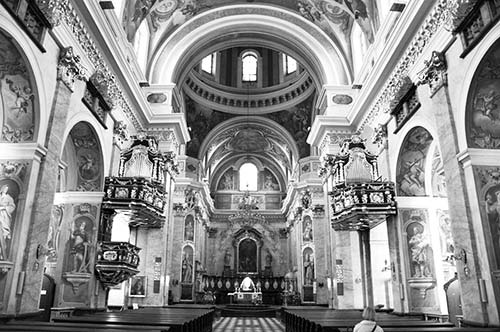
The cathedral’s interior is stunning Italian Baroque. The transept is surrounded by sculptures of four bishops of Roman Ljubljana (when it was called Emona, or Aemon). Left of the main altar, notice the distinctive chair. This was designed by the very religious Jože Plečnik, whose brother was a priest here. Look up over the nave to enjoy the recently restored, gorgeous ceiling fresco.
The dragon has been the symbol of Ljubljana for centuries, ever since Jason (of Argonauts and Golden Fleece fame) supposedly slew one in a nearby swamp. This is one of the few notable bits of Ljubljana architecture not by Plečnik (but by Jurij Zaninović, a fellow student of Vienna architect Otto Wagner). While the dragon is the star of this very photogenic Art Nouveau bridge, the bridge itself was officially dedicated to the 40th anniversary of Habsburg Emperor Franz Josef’s reign (see the dates on the side: 1848-1888). Tapping into the emp’s vanity got new projects funded—vital as the city rebuilt after the 1895 earthquake. But the Franz Josef name never stuck; those dragons are just too darn memorable.
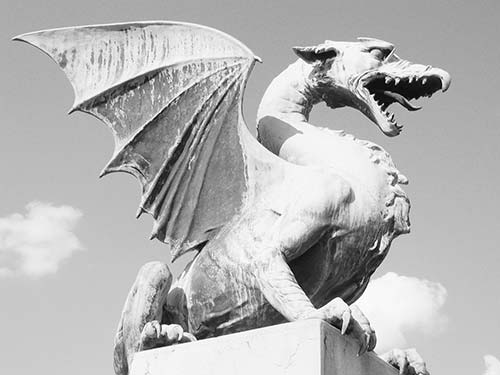
From the Dragon Bridge, it’s an easy funicular ride or steep hike up to Ljubljana Castle (described later). Or you can head back through the market to reach the Town Square and Old Town (see next), where I’ve narrated a self-guided shopping tour.
Ljubljana’s Town Square, just across the Triple Bridge and up the street from Prešeren Square, is home to the Town Hall (Rotovž), highlighted by its clock tower and pillared loggia. Step inside the Renaissance courtyard to see paintings, artifacts, and a map of late 17th-century Ljubljana. Studying this map, notice how the river, hill, and wall worked together to fortify the town. Courtyards like this (but humbler) are hidden throughout the city. As rent in these old places is cheap, many such courtyards host funky and characteristic little businesses. Be sure to get off the main drag and poke into Ljubljana’s nooks and crannies.
In the square between the Town Hall and the cathedral is a recent replica of the Fountain of Three Carniolan Rivers, inspired in style and theme by Rome’s many fountains. The figures with vases represent this region’s three main rivers: Ljubljanica, Sava, and Krka. This is one of many works in town by Francesco Robba, an Italian who came to Ljubljana for a job, fell in love with a Slovene, and stayed here the rest of his life—decorating the city’s churches with beautiful Baroque altars. At the nearby corner, check out the wild interior of the Nova KBM Bank, which looks more like a cutting-edge nightclub.
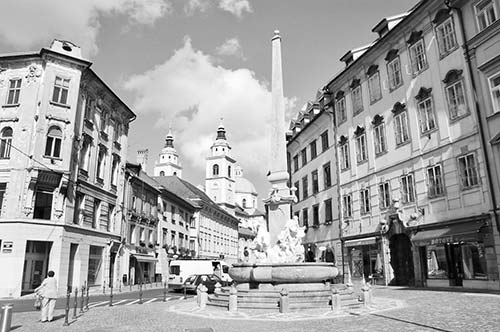
Now turn with your back to the fountain. You’re staring down the single street that constitutes Ljubljana’s Old Town. In the early 19th century, Ljubljana consisted mainly of this solitary main drag, running along the base of Castle Hill (plus a small “New Town” across the river). Stretching south from here are two other “squares”—Stari trg (Old Square) and Gornji trg (Upper Square)—which have long since grown together into one big, atmospheric promenade lined with quaint boutiques, great restaurants, and cafés. Virtually every house along this drag has a story to tell of a famous resident or infamous incident. As you walk, keep your eyes open for Ljubljana’s mascot dragon—it’s everywhere.
For a self-guided shopping stroll that runs the length of this delightful street—and highlights several fine shops en route—see “Shopping in Ljubljana,” later.
The castle above town offers enjoyable views of Ljubljana and the surrounding countryside. There has probably been a settlement on this site since prehistoric times, though the first true fortress here was Roman. The 12th-century version was gradually added on to over the centuries, until it fell into disrepair in the 17th century. Today’s castle—rebuilt in the 1940s and renovated in the 1970s—is a hollow-feeling replica, lacking any sense of real history. However, in recent years they’ve filled this shell with four worthwhile attractions and some respectable restaurants. It also offers a fine view, looking out over Ljubljana’s rooftops and to the Alps on the horizon. The castle is home to the Ljubljana Festival, with concerts throughout the summer (tel. 01/306-4293, www.ljubljanafestival.si).
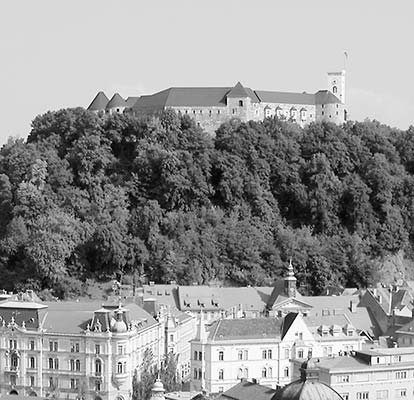
Cost and Hours: The grounds are free to visit and open daily April-Sept 9:00-23:00, Oct-March 10:00-21:00. Tickets and hours for the history exhibition, film, castle tower, and puppetry museum change from year to year. Most likely, you can pay €7.50 (or €10 with the round-trip funicular) for admission to all four. To add an audioguide or a guided tour (described next), you’ll pay a total of €10 (or €12 with the funicular). The attractions are open daily June-Sept 9:00-21:00, April-May and Oct 9:00-20:00, Nov 10:00-19:00, Dec-March 10:00-18:00, tel. 01/232-9994, www.ljubljanskigrad.si.
“Time Machine” Tours: Guides dressed as historical figures lead one-hour tours of the castle (€10 combo-ticket with castle sights, or €12 to add funicular; July-Sept 4/day, May-June 2/day, Oct-April 2/day Sat-Sun only, confirm schedule at information office or funicular ticket desk, tours depart from castle information center).
Getting to the Castle: A slick funicular whisks visitors to the top in a jiff (€2.20 one-way, €4 round-trip, also included in combo-tickets described above, runs every 10 minutes, 1-minute ride, daily April-Sept 9:00-23:00, Oct-March 10:00-21:00, catch it at Krekov trg—across the street from the market square TI). From the top, you’ll find free WCs and a few easy flights of stairs up into the heart of the castle complex (or take the elevator). Another sweat-free route to the top is via the tourist train that leaves at the top of each hour (or more frequently with demand) from the street in front of the Town Hall (€4 round-trip, daily in summer 9:00-21:00, shorter hours off-season, doesn’t run in snow or other bad weather). There are also two handy trails to the castle. The steeper-but-faster route begins near the Dragon Bridge: Find Študentovska lane, just past the statue of Vodnik in the market. This lane dead-ends at a gravel path, which you’ll follow up to a fork. Turn left to zigzag up the steepest and fastest route, which deposits you just below the castle wall; from here, turn left again and curl around the wall to reach the main drawbridge. Slower but a bit less steep is Reber, just off Stari trg, a few blocks south of the Town Hall: Walk up to the top of Reber, and, at the dead end, turn right and start climbing up the stairs. From here on out, keep bearing left, then go right when you’re just under the castle (follow Grad signs).
Visiting the Castle: The castle’s information office is on the courtyard above the top of the funicular. Across the way are the well-stocked Rustika gift shop and three eateries (the fancy Strelec; Gradska Kavana, the “castle café”; and the recommended Gostilna na Gradu, with traditional Slovenian cuisine). The upper floors house two wedding halls—Ljubljana’s most popular places to get married (free for locals).
Most of the sights worth seeing at the castle are in the opposite wing, clustered around the base of the tallest tower. As you face the tower, the entrance to the history exhibit is to the left, while the “Virtual Castle” film and tower climb itself are to the right. The Museum of Puppetry is near the information office.
The Slovenian History Exhibition offers a concise but engaging overview of this little country’s story. As you enter, ask to borrow the free audioguide, then head downstairs and work your way up. Dark display cases light up when you approach, revealing actual artifacts, video clips, and touchscreens with more information. A unique feature of the museum is that you’re invited to touch replicas of important historic items (in many cases, the originals are in other Ljubljana museums). Don’t miss the top floor of the exhibit (go up the glassed-in staircase), which is the most interesting—covering the tumultuous 20th century. You’ll learn about topics ranging from the battlefields of World War I, to the creation of the first Yugoslavia, to the fascist occupation and harrowing Italian-run concentration camps of World War II, to the cult of personality around Partisan war hero-turned-Yugoslav president Tito, to Slovenia’s bid for independence.
Entering the door to the right of the tower, you’ll first find the small penitentiary exhibit, recalling the post-Napoleonic era, when the castle was converted to a prison. It saw the most action during World War I, when it housed political prisoners (including the beloved Slovenian writer Ivan Cankar) and POWs. Modest exhibits inside actual former cells describe the history and list the names of past inmates.
If you head downstairs from the entrance, you’ll find a Gothic chapel with Baroque paintings of St. George (Ljubljana’s patron saint, the dragon-slayer) and coats of arms of the various aristocratic families that have called this castle home.
Heading up the stairs, you’ll find the informative, entertaining, and nicely animated “Virtual Castle” film, in which Ljubljana’s mascot dragon describes this hill’s layers of history (12 minutes, plays all day on the half-hour; often in English, but otherwise borrow English headset).
Finally, climb the 92 spiral steps up to the castle tower, with one of the best views in town.
Don’t miss the oddly fascinating Museum of Puppetry (ride up the elevator inside the gift shop near the castle information office). This traces the history of puppetry as an art form, which flourished in the Modernist milieu of early-20th-century Ljubljana. You’ll step into a surreal world of marionettes, shadow puppets, and other creations. This is not a goofy attraction for kids; in fact, some of the puppets are quite grotesque and disturbing. You’ll see marionettes of Adolf Hitler and Partisan troops, watch grainy footage of famous puppet masters (including Milan Klemenčič, who pioneered the form here in 1910), then climb up to the mezzanine and put on a show of your own.
Eating: Combine your visit to the castle with a meal at the recommended Gostilna na Gradu, with the best traditional Slovenian food in town (in the castle courtyard; described later, under “Eating in Ljubljana”). The pricey Strelec restaurant, while a bit pretentious, has a big-name chef and a growing reputation.
The Prešeren Square (west) side of the river is the heart of modern Ljubljana, and home to several prominent squares and fine museums. These sights are listed roughly in order from Prešeren Square and can be linked to make an interesting walk.
• Leave Prešeren Square in the direction the poet is looking, bear to your left (up Wolfova, by the picture of Julija), and walk a block to...
This grassy, tree-lined square hosts big events. It’s ringed by some of Ljubljana’s most important buildings: the University headquarters, the Baroque Ursuline Church of the Holy Trinity, a classical mansion called the Kazina, and the Philharmonic Hall. The green belt at the heart of the square, called Park Zvezda (“Star Park”) for its radiating paths, is fronted by several inviting cafés and restaurants; the recommended Zvezda Kavarna is a top spot for its local cakes and ice cream.
At the top end of the square, by the entry to a pedestrian underpass, a Roman sarcophagus sits under a gilded statue of a Roman citizen—a replica of a Roman tomb sculpture from 1,700 years ago, when this town was called Emona. The busy street above you has been the site of the main trading route through town since ancient Roman times. Information boards tell you more.
Take a few steps into the underpass, and look left to find the easy-to-miss Chopin Passage (Chopinov Prehod), which displays exposed parts of the original Roman-era road and a model of Emona in ancient times.
• Continue the rest of the way through the underpass beneath Slovenska cesta, then walk straight through the gap in the Maxi shopping mall into the...
This unusual plaza is ringed by an odd collection of buildings. While hardly quaint, the Square of the Republic gives you a good taste of a modern corner of Ljubljana. And it’s historic—this is where Slovenia declared its independence in 1991.

The twin office towers (with the world’s biggest digital watch, flashing the date, time, and temperature) were designed by Plečnik’s protégé, Edvard Ravnikar. As harrowing as these structures seem, imagine if the builders had followed the original plans—the towers would be twice as tall as they are now and connected by a bridge, representing the gateway to Ljubljana. These buildings were originally designed as the Slovenian parliament, but they were scaled back when Tito didn’t approve (since it would have made Slovenia’s parliament bigger than the Yugoslav parliament in Belgrade). Instead, the Slovenian Parliament is across the square, in the low-profile office building with the sculpted entryway. The carvings are in the Socialist Realist style, celebrating the noble Slovenian people conforming to communist ideals for the good of the entire society. Completing the square are a huge conference center (Cankarjev Dom, the white building behind the skyscrapers), a shopping mall, and some public art.
• Just a block north, across the street and through the grassy park (Trg Narodni Herojev), you’ll find the...
These two museums share a single historic building facing a park behind the Parliament. They’re both average but worth considering if you have a special interest or if it’s a rainy day.
The National Museum occupies the ground floor, featuring a lapidarium with carved-stone Roman monuments and exhibits on Egyptian mummies. (Temporary exhibits are also on this level.) Upstairs and to the right are more exhibits of the National Museum, with archaeological findings ranging from old armor and pottery to the museum’s two prized possessions: a fragment of a 45,000-year-old Neanderthal flute fashioned from a cave bear’s femur—supposedly the world’s oldest musical instrument; and the “figural situla,” a beautifully decorated hammered-bronze bucket from the fifth century B.C. Embossed with scenes of everyday Iron Age life, this object has been a gold mine of information for archaeologists.
Upstairs and to the left is the Natural History exhibit, featuring the flora and fauna of Slovenia. You’ll see partial skeletons of a mammoth and a cave bear, plenty of stuffed reptiles, fish, and birds, and an exhibit on “human fish” (Proteus anguinus—long, skinny, pale-pink, sightless salamanders unique to caves in this part of Europe).
Cost and Hours: €6 for National Museum, €4 for Natural History Museum, or €8.50 for both, some English descriptions, both open daily 10:00-18:00, Thu until 20:00, Prešernova 20, tel. 01/241-4400, www.nms.si and www.pms-lj.si.
• At the far end of the building is a glassed-in annex displaying Roman stone monuments (free). Turning left around the museum building and walking one block, you’ll see the...
This pretty yellow chalet (with brown trim and a red roof, at Prešernova cesta 31) wins my vote for quaintest embassy building in the world. Resist the urge to snap a photo...those guards are all business.
• Just up Prešernova cesta from the embassy are two decent but skippable art museums.
This museum has three parts: European artists (in the new building), Slovenian artists (in the old building), and temporary exhibits. Find the work of Ivana Kobilca, a late 19th-century Slovenian Impressionist. Art lovers enjoy her self-portrait in Summer. If you’re going to Bled, you can get a sneak preview with Marko Pernhart’s huge panorama of the Julian Alps.
Cost and Hours: €5, special exhibits typically cost extra, permanent collection free first Sun of the month, open Tue-Sun 10:00-18:00, closed Mon; if main entrance at Cankarjeva 20 is closed for renovation, use the other entrance at the big glass box between two older buildings at Prešernova 24; tel. 01/241-5418, www.ng-slo.si.
Newly renovated, this museum has a permanent collection of modern and contemporary Slovenian artists, as well as temporary exhibits by both homegrown and international artists. To explore the “Continuities and Ruptures” permanent collection (aptly named for a place with such a fractured, up-and-down recent history), borrow the English floor plan and take a chronological spin through the 20th century. Unusual for a “modern” art museum is the room with Partisan art, with stiff, improvised, communist-style posters from the days when Tito and his crew were just a ragtag militia movement.
Cost and Hours: €5, ask about combo-ticket with contemporary branch at Metelkova—see here, Tue-Sun 10:00-18:00, Thu until 20:00 in July-Aug, closed Mon, Tomšičeva 14, tel. 01/241-6800, www.mg-lj.si.
• By the busy road near the art museums, look for the distinctive Neo-Byzantine design (tall domes with narrow slits) of the...
Ljubljana’s most striking church interior isn’t Catholic, but Orthodox. This church was built in 1936, soon after the Slovenes joined a political union with the Serbs. Wealthy Slovenia attracted its poorer neighbors from the south—so it built this church for that community. Since 1991, the Serb population continues to grow, as people from the struggling corners of the former Yugoslavia flock to prosperous Slovenia. Its gorgeous interior—which feels closer to Moscow than to Rome—offers visitors a taste of this important faith.
Cost and Hours: Free, daily 8:00-19:00; divine liturgy Sun at 11:00, other days services at 8:30 and 18:00; Prešernova cesta 35, www.spc-ljubljana.si.
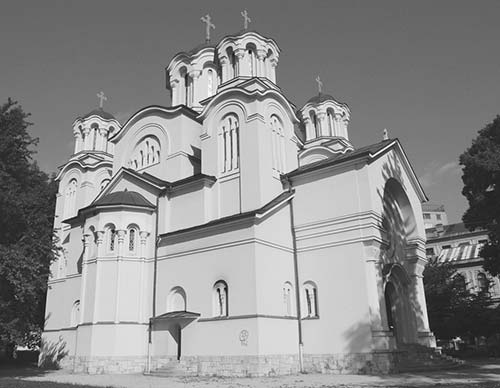
Visiting the Church: Step inside for the best glimpse of the Orthodox faith this side of Dubrovnik. The church is colorfully decorated without a hint of the 21st century, mirroring a very conservative religion. Many of the church’s colorful frescoes are copies of famous frescoes that decorate medieval Serbian Orthodox monasteries throughout the Balkans. On the balcony (at the back of the nave), you’ll see Cyrillic script that explains the history of the church. Notice that there are no pews, because worshippers stand throughout the service. On the left, find the little room with tubs of water, where the faithful light tall, skinny beeswax candles (purchased at the little window in the back corner). The painted screen, or iconostasis, is believed to separate our material world from the spiritual realm behind it. Ponder the fact that several centuries ago, before the Catholic Church began to adapt to a changing world, all Christians worshipped this way. For more on the Orthodox faith, see the sidebar on here).
• On the other side of the busy street is...
This huge park, just west of the center, is where Slovenes relax on summer weekends. The easiest access is through the graffiti-covered underpass from Cankarjeva cesta (between the Serbian Orthodox Church and the Museum of Modern Art). As you emerge, the Neoclassical pillars leading down the promenade clue you in that this part of the park was designed by Jože Plečnik. Along this “main boulevard” of the park, various changing photographic exhibitions are displayed.
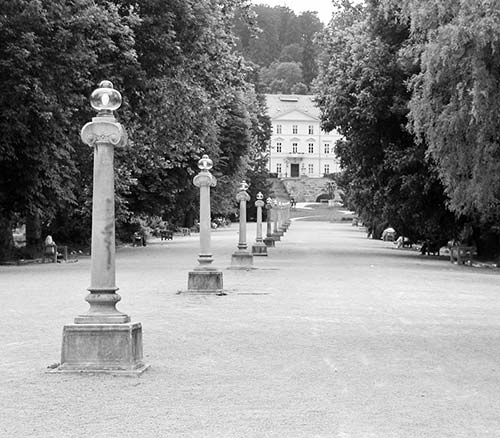
• Aside from taking a leisurely stroll, the best thing to do in the park is visit the...
In a Baroque mansion (Cekinov Grad) in Tivoli Park, a well-done exhibit called “Slovenians in the 20th Century” traces the last hundred years of Slovenia—essentially from the end of World War I to independence in 1991. Out front is a T-55 Yugoslav tank that was commandeered by the Slovenes during their war for independence. Inside, the ground floor displays temporary exhibits, and upstairs you’ll find several rooms using models, dioramas, light-and-sound effects, and English explanations to creatively tell the story of one of Europe’s youngest nations. While it’s a little difficult to fully appreciate, the creativity and the spunky spirit of the place are truly enjoyable.
Cost and Hours: €3.50, permanent exhibit free first Sun of the month, guidebook-€5, open Tue-Sun 10:00-18:00, closed Mon, in Tivoli Park at Celovška cesta 23, tel. 01/300-9610, www.muzej-nz.si.
Getting There: The museum is a 20-minute walk from the center, best combined with a wander through Tivoli Park. The fastest approach: As you emerge from the Cankarjeva cesta underpass into the park, climb up the stairs, then turn right and go straight ahead for five minutes. You’ll continue straight up the ramp, then turn left after the tennis courts and look for the big pink-and-white mansion on the hill.
Visiting the Museum: The exhibit begins at the dawn of the 20th century, during Slovenia’s waning days as part of the Austro-Hungarian Empire. You’ll walk through a simulated trench from the Soča Front, then learn about the creation of the post-World War I Kingdom of Serbs, Croats, and Slovenes (or, as this exhibit pointedly puts it, “Kingdom of Slovenes, Croats, and Serbs”).
Your footfalls echo loudly as you enter the room describing Slovenia’s WWII experience (ask them to start the 12-minute “multivision” wrap-around slideshow, with music and sound effects). You’ll learn how during that war, Slovenia was divided between neighboring fascist powers Germany, Italy, and Hungary. Each one tried (but failed) to exert linguistic and cultural control over the people, hoping to eradicate the Slovenian national identity. Video screens show subtitled interviews with people who lived through those war years.
Passing through the ballroom, you reach the “Slovenia 1945-1960” exhibit, outlining both the good (modernization) and the bad (prison camps and secret police) of the early Tito years. Despite his ruthless early rule, Tito remains popular here; under his stern bust, page through the photo album of Tito’s visits to Slovenia. Find the display of the country’s former currencies. Examining the Yugoslav dinar, notice that the figureheads on that communist currency were generic, idealized workers, farmers, and other members of the proletariat...except for a few notable individuals (including Tito). Meanwhile, Slovenia’s short-lived post-Yugoslav currency, the tolar (1991-2006, R.I.P.), featured artists and scientists rather than heads of state and generals.
The most evocative room has artifacts from the Slovenes’ brave declaration of independence from a hostile Yugoslavia in 1991. The well-organized Slovenes had only to weather a 10-day skirmish to gain their freedom. It’s chilling to think that at one point bombers were en route to level this gorgeous city. The planes were called back at the last minute, by a Yugoslav People’s Army officer with allegiances to Slovenia.
• Hungry? Straight ahead and down the stairs from the museum, look for the “Hot Horse” food kiosk, selling €4 horseburgers (no joke). A local institution, this is a popular place to get together with friends and neighbors. The giant, modern, blocky, light-blue building across the busy road is the Pivovarna Union—the brewery for Ljubljana’s favorite beer.
On your way back to the center, you could stop by...
This 1933 building was the first skyscraper in Slovenia, for a time the tallest building in Central Europe, and one of the earliest European buildings that was clearly influenced by American architecture. Art Deco inside and out, it’s a thrill for architecture fans and anyone who enjoys a great view—the top floor, which hosts a pricey restaurant, café, and observation deck, offers the best panorama of Ljubljana’s skyline. Zip up in the elevator just to take a peek, or stay for a drink or meal.
There are three levels: The best is floor #12, where you can sit outside (or, in bad weather, head up the spiral stairs to the glassed-in terrace) and enjoy a drink with unobstructed views over the city and castle (€3 beer/wine/coffee, €5-8 cocktails, €5-7 light food). One floor below (#11) is the indoor club/lounge, with a similar menu. And on the next floor down (#10) is the restaurant, with pricey food (€10-19 main courses) and less-impressive views. The good-value €8 lunch deals are available in either place. I’d skip the restaurant and the club, and just grab a drink or snack up on the terrace.
Cost and Hours: Free to ride the elevator up for a peek, but you should buy at least a drink if you want to stick around; terrace and club open daily 9:00-very late; restaurant open Mon-Sat 12:00-21:00, closed Sun; 2 blocks from Prešeren Square at Štefanova 1, tel. 040-601-787, www.neboticnik.si.
• A few blocks south, near several Jože Plečnik sights (see next section) at the river end of French Revolution Square, you’ll find the...
This thoughtfully presented museum, located in the recently restored Auersperg Palace, offers a high-tech, in-depth look at the story of this city. Though everything is well-described in English (and touchscreens provide even more information), a student on the museum’s staff might be able to show you around if it’s not too busy—ask.
Cost and Hours: €6, Tue-Sun 10:00-18:00, Thu until 21:00, closed Mon, kid-friendly, Gosposka 15, tel. 01/241-2510, www.mgml.si.
Visiting the Museum: You’ll begin your visit in the cellar, with Roman ruins (including remains of the original Roman road and sewer system, found right here) and layers of medieval artifacts. A model of the modern city—sitting upon footprints of the Roman (red) and medieval (blue) settlements—illustrates Ljubljana’s many layers of history. If it’s not traveling to other museums (as it usually is), you may see the world’s oldest wooden wheel on an axle, dating from around 3200 B.C. and discovered in the Ljubljana marshlands. Upstairs are the mayor’s room (with a few exhibits) and the ever-evolving permanent collection, called Faces of Ljubljana. Exhibits on economy and trade include communist-era advertisements, while another section explains how Ljubljana has belonged to 10 different states over the last 200 years, ranging from the genteel Habsburg Empire to the oppressive Nazi regime to membership in the benevolent EU. You’ll also see an actual Fiat Zastava 750 car, the classic “Fičko” car that everyone owned—or wanted to own—in communist Yugoslavia (sort of a proto-Yugo). Rounding out the collection is a range of temporary exhibits.
Nearby: Your ticket includes admission to two archaeological sites nearby (summer only)—pick up a map at the front desk.
• If visiting the museum, don’t miss the nearby National and University Library and French Revolution Square—both described in the next section.
Jože Plečnik is to Ljubljana what Antoni Gaudí is to Barcelona: a homegrown, amazingly prolific genius who shaped his town with a unique and beautiful vision. And Plečnik’s mark on Ljubljana, much like Gaudí’s on Barcelona, has a way of turning people who couldn’t care less about architecture into fans. There’s plenty to see. In addition to the Triple Bridge, the riverside market, and the sights listed here, Plečnik designed the embankments along the Ljubljanica and Gradaščica rivers in the Trnovo neighborhood; the rebuilt Roman wall along Mirje street, south of the center; the Church of St. Francis, with its classicist bell tower; St. Michael’s Church on the Marsh; Orel Stadium; Žale Cemetery; and many more buildings throughout Slovenia.
Some of the best Plečnik sights are near the river, just south of Congress and Prešeren squares. I’ve linked them into a short self-guided walk.
• From Prešeren Square, stroll south along the river. After the plain bridge called Brv, you’ll come to the...
Named for the actual cobblers who set up shop along the river in olden times, the bridge encapsulates Plečnik’s style perhaps better than any other structure: simple, clean lines adorned with classical columns. Ideal for people-watching (with the castle hovering scenically overhead), this is one of Ljubljana’s most appealing spots.
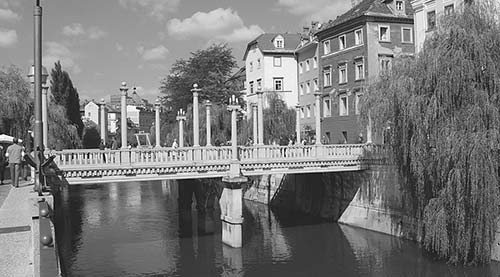
• Continue past Cobblers’ Bridge on the right side of the river, past the fountain. After about a block, turn right up the parked-up street called Novi trg. At the top of this street, on the left, is a red-brick building embedded with gray granite blocks in an irregular checkerboard pattern. This is the...
Widely regarded as Plečnik’s masterpiece, this building is a bit underwhelming...until an understanding of its symbolism brings it to life.
Cost and Hours: Free, staircase open Mon-Fri 8:00-20:00, Sat 9:00-14:00, closed Sun. The quiet main reading room is officially open for visitors only mid-July-mid-Aug Mon-Sat 14:00-18:00.
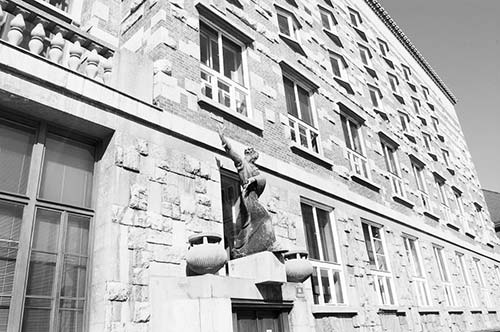
Visiting the Library: Begin by standing outside and surveying the exterior. On the surface, the red-and-gray color scheme evokes the red soil and chunks of granite of the Karst region, south of Ljubljana. But on a deeper level, the library’s design conveys the theme of overcoming obstacles to attain knowledge. In the facade, the blocks of irregular size and shape represent a complex numerological pattern that suggests barriers on the path to enlightenment. The sculpture on the river side is Moses—known for leading his people through 40 years of hardship to the Promised Land. On the right side of the building, find the horse-head doorknobs—representing the winged horse Pegasus (grab hold, and he’ll whisk you away to new levels of enlightenment).
Step inside. The main staircase is dark and gloomy—modeled after an Egyptian tomb. But at the top, through the door marked Velika Čitalnica, is the bright, airy main reading room: the ultimate goal, a place of learning. The top-floor windows are shaped roughly like open books. Sadly, except for one month a year when the students are on summer break, you can’t actually enter the reading room; you’ll just have to look at postcards in the shop, and imagine young Ljubljanans hunched studiously over their books, surrounded by Plečnik’s bookshelves, railings, and high windows.
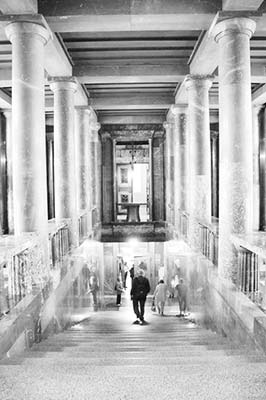
Aside from being a great work of architecture, the building also houses the most important library in Slovenia, with more than two million books (about one per Slovene). The library is supposed to receive a copy of each new book printed in the country. In a freaky bit of bad luck, this was the only building in town damaged in World War II, when a plane crashed into it. But the people didn’t want to see their books go up in flames—so hundreds of locals formed a human chain, risking life and limb to save the books from the burning building.
• Directly behind the library is a mellow square with an obelisk in the middle. This is...
Plečnik designed the obelisk in the middle of the square to commemorate Napoleon’s short-lived decision to make Ljubljana the capital of his Illyrian Provinces. It’s rare to find anything honoring Napoleon outside of Paris, but he was good to Ljubljana. Under his rule, Slovenian culture flourished, the Slovene language became widely recognized and respected for the first time, schools were established, and roads and infrastructure were improved. The monument contains ashes of the unknown French soldiers who died in 1813, when the region went from French to Austrian control.
The Teutonic Knights of the Cross established the nearby monastery (Križanke, ivy-capped wall and gate, free entry) in 1230. The adaptation of these monastery buildings into the Ljubljana Summer Theatre was Plečnik’s last major work (1950-1956).
• From here, it’s a scenic 10-minute walk to the next sight. From the obelisk, walk down Emonska toward the twin-spired church. You’ll pass (on the left) the delightful Krakovo district—a patch of green countryside in downtown Ljubljana. Many of the veggies you see in the riverside market come from these carefully tended gardens. When you reach the Gradaščica stream, head over the bridge (also designed by Plečnik) and go around the left side of the church to find the house.
One of Ljubljana’s most interesting sights is the house of the architect who redesigned much of the city. Today the house is decorated exactly as it was the day Plečnik died, containing much of his equipment, models, and plans. The house can be toured only with a guide, whose enthusiasm brings the place to life. There are very few barriers, so you are in direct contact with the world of the architect. Still furnished with unique, Plečnik-designed furniture, one-of-a-kind inventions, and favorite souvenirs from his travels, the house paints an unusually intimate portrait of an artist. While the house initially underwhelms some visitors, it’s a ▲▲▲ pilgrimage for those who get caught up in Ljubljana’s idiosyncratic sense of style.
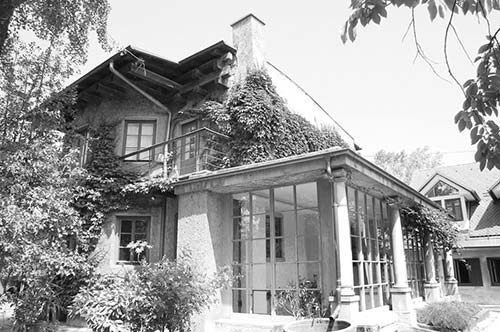
Cost and Hours: €6, Tue-Sun 10:00-18:00—last tour departs at 17:00, closed Mon, 45-minute English tours begin at the top of each hour, Karunova 4, tel. 01/280-1600, www.mgml.si.
Getting There: It’s directly behind the twin steeples of the Trnovo Church. The 15-minute stroll from the center—the same one Plečnik took to work each day—is nearly as enjoyable as the house itself. You can either walk south along the river, then turn right onto Gradaška and stroll along the stream to the church; or, from French Revolution Square, head south on Emonska. Either way, you’ll pass through the garden-patch district of Krakovo, where pea patches and characteristic Old World buildings gracefully cohabitate. On the way to or from the museum, it’s enjoyable to get a meal in Krakovo (two great restaurants—Pri Škofu and Manna—are described later, under “Eating in Ljubljana”).
Background: Ljubljana’s favorite son lived here from 1921 until his death in 1957. He added on to an existing house, building a circular bedroom for himself and filling the place with bric-a-brac he designed, as well as artifacts, photos, and gifts from around the world that inspired him as he shaped Ljubljana. Living a simple, almost monastic lifestyle, Plečnik knew what he liked, and these tastes are mirrored in his house.
Visiting the House: While waiting for your tour to begin, explore the modest but engaging museum, offering biographical details about Plečnik. In one room, a model of Ljubljana locates the many structures he designed all around the city. You’ll also see descriptions and photos of his greatest works, and large wooden models of two of his biggest “unrealized projects” that never made it off the drawing board: the cone-shaped national acropolis and the roofed Butchers’ Bridge at the market.
The tour takes you through the actual rooms where Plečnik lived: kitchen, circular bedroom, sitting room, studio, and greenhouse. As you tour the place, be patient. Listen to its stories. Appreciate the subtle details. Notice how reverently your guide (and other Slovenes) speaks of this man. Contrast the humbleness of Plečnik’s home with the dynamic impact he had on the cityscape of Ljubljana and the cultural heritage of Slovenia. Wandering Plečnik’s hallways, it’s hard not to be tickled by this man’s sheer creativity and by the unique world he forged for himself to live in. As a visitor to his home, you’re in good company. He invited only his closest friends here—except during World War II, when Ljubljana was occupied by Nazis and the university was closed, and Plečnik allowed his students to work with him here.
Three museums face each other on a slick modern plaza next to the park called Tabor, about a 15-minute walk northeast of Prešeren Square in the dull but up-and-coming district of Metelkova. Nearby, you can explore the funky squatters’ colony of Metelkova City (with Ljubljana’s famous prison-turned-youth hostel).
Housed in a state-of-the-art facility, this delightful museum is Ljubljana’s most underrated attraction. With both permanent and temporary exhibits, the museum strives to explain what it is to be Slovene, with well-presented and well-described cultural artifacts from around the country. If you’ve caught the Slovenian folk culture itch, this is the place to scratch it.
Cost and Hours: €4.50, free first Sun of month, Tue-Sun 10:00-18:00, closed Mon, great café, Metelkova 2, tel. 01/300-8745, www.etno-muzej.si.
Visiting the Museum: The ground and first floors have good temporary exhibits, while upstairs you’ll find two permanent exhibits.
The best exhibit, filling the third floor, is called “Between Nature and Culture.” As you exit the elevator, turn left and find the shrunken head, which comes with a surprisingly frank exhibit that acknowledges the shortsighted tendency for museum curators—including at this museum—to emphasize things that are foreign or different. Continue through collections of “Reflections of Distant Worlds” (non-European cultures) to reach the core of the collection, which focuses on Slovenia. A good but slow-moving film visits the country’s four major regions. Another exhibit ponders how people half a world away—in Slovenia and in North America—simultaneously invented a similar solution (snowshoes) for a common problem. One display deconstructs Slovenian clichés (including this country’s odd fascination with its traditional hayracks). The arrangement of the collection emphasizes the evolution of an increasingly complicated civilization, from basic farming tools to ceramics to modern technology. You’ll see exhibits on traditional Slovenian beekeeping, blacksmithing, weaving, shoemaking, costumes and customs, pottery, furniture, and religious objects. The children’s “Ethnoalphabet” area features an A-to-Ž array of engaging, hands-on activities.
The other permanent exhibit, on the second floor (from the elevator, turn left to find the entrance), is called “I, We, and Others.” A bit too conceptual for its own good, this heady exhibit ponders the notion of belonging. Designed for Slovenes more than foreigners (with very limited posted English information—borrow the free English audioguide from the ticket desk before heading up), it explores various aspects of how people define who they are, from individual and family to community and nation. Videos and sounds enhance the exhibits, and the curators neatly juxtapose well-known icons from different cultures (such as various national parliament buildings) in thought-provoking ways. While it’s easy to get lost amid the navel-gazing, there is something particularly poignant about this topic here in the identity-obsessed Balkans.
Next door to the Ethnographic Museum is this facility, where items from the Slovenian National Museum that were formerly tucked away in storage are now displayed on two floors. The very pretty historical bric-a-brac is neatly presented without much context—it’s just an excuse to get a bunch of interesting stuff out into public view. Each room has a different collection: furniture, pottery and ceramics, church vestments, weapons and armor, and more. The painting gallery is nicely organized by century and style. The museum also features temporary exhibits. Everything’s labeled in English, and a guide can show you around, if they’re not too busy.
Cost and Hours: €6, Tue-Sun 10:00-18:00, closed Mon, Maistrova 1, tel. 01/230-7032.
This cutting-edge branch of the Museum of Modern Art opened in 2012 to showcase changing exhibitions of present-day, mostly Slovenian and Eastern European artists. In addition to temporary installations, it populates its permanent “The Present and Presence” exhibit with a variety of pieces from its collection. The modern space is at once sleek and playful, making this museum worth a visit for art lovers who appreciate works from the 1960s to the present.
Cost and Hours: €5, ask about combo-ticket with Museum of Modern Art, Tue-Sun 10:00-18:00, closed Mon, Maistrova 3, tel. 01/241-6825, www.mg-lj.si.
The heart of Slovenia’s counterculture, this former military installation is now a funky, graffiti-and-wild-art-slathered squatter’s colony, billed as an “autonomous cultural center.” Built by the Habsburgs in the 1880s, the complex—with barracks, warehouses, and a prison—was used by a laundry list of later occupiers, from Italian fascists to Nazis to the Yugoslav People’s Army. After Yugoslavia pulled its troops out of Slovenia (following the Ten-Day War), the cluster of buildings sat derelict and abandoned. In 1993, transient artists moved into the sprawling complex and set up galleries, theaters, bars, and nightclubs. While controversial at first, Metelkova City has gradually become accepted by most Ljubljanans, and the city (which owns the property) not only tolerates but, in subtle ways, encourages this hotbed of youthful artistic expression. While edgy, this place is fascinating to explore—it’s sleepy by day and lively by night (www.metelkovamesto.org).
Anchoring the area is Hostel Celica, one of Europe’s most unusual youth hostels, which fills a former prison building. Twenty artists were invited to decorate cells that have been turned into accommodations, and the ground floor features vibrant public spaces, a good and affordable restaurant (a nice place for a lunch or a light dinner), and a shoes-off “Oriental café.” The message: Thoughtful art and architecture can transcend an ugly history. You can drop by to see the building anytime, and ask to borrow a flashlight to explore the dank and gloomy basement solitary confinement cells, with a small but interesting exhibition on the history of the building (and the various prisoners who have called it home—including Janez Janša, who did time here during communism and later became Slovenia’s prime minister). But if you’re interested in this place, make a point to visit at 14:00 for a free guided tour of the entire complex (tours run daily; you can also try calling to arrange a tour at other times, tel. 01/230-9700, www.hostelcelica.com).
Ljubljana, with its easygoing ambience and countless boutiques, is made to order for whiling away an afternoon shopping. It’s also a fun place to stock up on souvenirs. Popular items include wood carvings and models (especially of the characteristic hayracks that dot the countryside), different flavors of schnapps (the kind with a whole pear inside—cultivated to actually grow right into the bottle—is a particularly classy gift), honey mead brandy (medica—sweet and smooth), bars of soap wrapped in wool (good for exfoliating), and those adorable painted panels from beehives (described on here). Rounding out the list of traditional Slovenian items are wrought-iron products from Kropa, crystal from Rogaska, lace from Idrija, and salt from Piran.
There are two convenient areas in the city center that offer abundant shopping opportunities: at Ciril-Metodov trg and near the market; and, beginning a few steps away, the Old Town pedestrian lane that cuts through the downtown core. I’ve described options in both places below. (A third street worth exploring—with a bit more funky student style—is the graffiti-slathered Trubarjeva cesta, a block up from the river and easy to find from Prešeren Square.)
The most atmospheric trinket-shopping is in the first stretch of the market colonnade, along the riverfront next to the Triple Bridge (described earlier, under “Sights in Ljubljana”).
If you’re looking for serious handicrafts rather than trinkets, drop by the Rustika gallery, just over the Triple Bridge (on the castle side). In addition to beehive panels, they also have lace, painted chests and boxes, and other tasteful local-style mementos (daily 9:00-21:00, Stritarjeva 9, mobile 031-459-509). There’s another Rustika location up at the castle courtyard. A somewhat more downscale souvenir shop with a wide variety is Dom Trgovina, across from the TI on the main market square (Mon-Sat 9:00-21:00, Sun 10:00-21:00, Ciril-Metodov trg 5).
Kraševka sells high-quality artisanal products (mostly foods) from the Karst region, and also acts as a sort of information office for that area (Mon-Fri 9:00-19:00, Sat 9:00-15:00, closed Sun, Ciril-Metodov trg 10, tel. 01/232-1445).
Trgovina Ika, a small artisan boutique with its own hip and idiosyncratic sense of style, is a delightful place to browse for truly authentic Slovenian stuff that goes beyond souvenirs. Its unique items by local designers—jewelry, hats, scarves, shoes, and so on—are modern and fashionable (Mon-Fri 10:00-19:30, Sat 9:00-18:00, Sun 10:00-14:00, Ciril-Metodov trg 13, tel. 01/123-21743).
Ljubljana’s main Old Town street—which changes names from Mestni trg to Stari trg, then Gornji trg—is also lined with several characteristic shops, selling a few of the unique gift items produced in this proud little country. Here’s a lightly narrated tour of this inviting street, from start to finish. Unless otherwise noted, all of these shops are open long hours on weekdays (often until 20:00); most close a bit earlier on Saturdays (around 17:00), and close in the early afternoon on Sundays (usually by 13:00 or 14:00).
 Self-Guided Shopping Stroll: Begin in front of the Town Hall. Before you start the walk, take the opportunity to browse the shops along Ciril-Metodov trg, noted above (all of which are within a five-minute walk of here). When you’re ready, head down the street.
Self-Guided Shopping Stroll: Begin in front of the Town Hall. Before you start the walk, take the opportunity to browse the shops along Ciril-Metodov trg, noted above (all of which are within a five-minute walk of here). When you’re ready, head down the street.
First, on the left at Mestni trg 6, look for two fun shops: Dvorec Trebnik sells cosmetics and bath products handmade by people with disabilities; Smile is a colorful design/concept store. A few steps farther along at #7, Honey House sells products harvested by beekeeper Luka (closed Sun). For tips on browsing your honey options, see here.
Just beyond at #8, Piranske Soline sells products from the giant salt pans that sit just south of Piran on Slovenia’s tiny coastline. You can pick up some locally harvested sea salt, or peruse their salt-based beauty products (bath salts, body milk, and other exfoliants, www.soline.si).
Across the street at #19, Güjžina highlights food, wines, and other products from the Hungarian-influenced region of Slovenia called Prekmurje (also called Pannonia). While the restaurant (on the left, €11-16 meals) is hit-or-miss, their wine bar (on the right) is a good place to learn more about the products of one of Slovenia’s top wine-growing regions. If you want a dessert, this is a fine place to try the cake called gibanica—originating in Prekmurje, and beloved throughout Slovenia.
Back on the left, at #8, La Chocolate is the first of two artisanal čokoladnice (chocolate shops) along this strip (www.lachocolate.si).
Farther along, on the right (at #17), Galerija Idrijske Čipke shows off handmade lace from the town of Idrija (www.idrija-lace.com).
Continuing past various clothes boutiques, look for (on the left, at #11) another chocolate shop, Čokoladnica Cukrček. A bit pricier than La Chocolate, this shop is best known for its foil-wrapped “Prešeren Balls” chocolates—a clever and civic-minded takeoff on Salzburg’s “Mozart Balls,” replacing the composer with Slovenia’s greatest poet (www.cukrcek.si).
Continue along the street (which here changes names from Mestni trg to Stari trg), passing more clothes shops. On the left, at Stari trg 3, look for Cha tea shop, which sells over 100 varieties of tea, plus porcelain teapots and cups from all over. It’s attached to the recommended Čajna Hiša teahouse.
A few steps down on the left (at #5), Cafetino is the best place in town for coffee. They have more than 20 types available—espresso or Turkish-style, plus beans to take home.
Next door, follow the passage to reach Za Popen’t Pivoteka, a “bottle shop” selling 200 kinds of beer in individual bottles. While they stock a few Slovenian beers, they focus on international microbrews—including several American brands. Even if it’s not authentically Slovenian, this shop is a fun browse for beer lovers. The name is a play on words, loosely meaning “foamy goodness” (www.zapopent.si). In the same courtyard is the stylish Formadoma design shop, specializing in housewares (closed Sun, www.formadoma.eu).
Now you’ll wade through a stretch of enticing restaurants with wonderful outdoor tables (for my recommendations here, see here). Notice Julija and Romeo, facing each other wistfully across the street.
After the little “restaurant row,” the lineup of shops resumes. On the left at Stari trg 11A, look for Patrizia jewelry; a few doors down, Wool Art Knitwear has unique (and very well-insulated) Serbian-style clothing. Across the street at #18, Babushka Boutique sells creative prints and Pinteresty gifts (www.babushkaboutique.com).
From here, you’ll pass a few more funky shops, as well as some rare books and antiques shops. On the right at #26, don’t miss Woodway, with locally-made wooden jewelry, sunglasses, and phone cases, and cork handbags and wallets from Portugal (www.woodway.si).
The cobbled charm culminates at the square called Gornji trg. Look uphill and notice the village charms of some of the oldest buildings in town: four medieval houses with rooflines slanted at the ends, different from the others on this street.
Ljubljana has good accommodations in all price ranges. I’ve focused my listings in or within easy walking distance of the city center. To get the best value, book ahead. The most expensive hotels raise their prices even more during conventions (Sept-Oct, and sometimes also June).
Boutique Hotels in the Old Town: Three similar (but unrelated) boutique hotels cluster idyllically on a cobbled square in Ljubljana’s Old Town. While quite overpriced (catering to deep-pocketed business travelers), they offer Old World charm with upscale touches. All of these are in old buildings with period touches; expect lots of stairs and no elevators. $$$$ Hotel Angel, part of the Lesar group, is the plushest of the bunch. Its 12 rooms have crisp white decor (air-con, pay parking, Gornji trg 7, tel. 01/425-5089, www.angelhotel.si, info@angelhotel.si, warm Jovan). $$$ Allegro Hotel has a musical theme and 17 rooms with hardwood floors around a checkerboard-tiled garden courtyard (cheaper rooms with shared bath, air-con, prebook for pay parking, Gornji trg 6, mobile 059-119-620, www.allegrohotel.si, info@allegrohotel.si). The family-run $$$ Antiq Hotel is a bit older, with less polish and 16 idiosyncratically decorated rooms sprawling through two buildings with a mazelike floor plan (cheaper rooms with shared bath, air-con, some rooms have low beams and doorways, Gornji trg 3, tel. 01/421-3560, www.antiqhotel.eu, info@antiqhotel.eu).
$$$$ Vander Urbani Resort is a unique concept: Nestled central as can be just off the in-love-with-life riverfront embankment, it really does feel like an intensely hip resort in the city center—right down to the minuscule rooftop swimming pool and sundeck. The resort prides itself on the cutting-edge urban design of its 16 rooms, and tries to use Slovenian and organic products wherever possible (air-con, elevator, café, restaurant, champagne bar, Krojaška ulica 6-8, tel. 01/200-9000, www.vanderhotel.com, info@vanderhotel.com).
$$$$ Cubo Hotel is a jolt of trendy minimalism on Ljubljana’s hotel scene. Its 26 rooms are the best place in town for sleek, mod elegance. Choose between streetside rooms, which enjoy castle views but get some traffic noise, or quieter courtyard rooms (air-con, elevator, Slovenska cesta 15, tel. 01/425-6000, www.hotelcubo.com, reception@hotelcubo.com).
$$$ Adora Hotel, on the other side of the church from the three boutique hotels described earlier, is a bit less charming, but also cheaper and very comfortable. Its 10 rooms have a restrained rustic style (air-con, elevator, free loaner bikes, pay parking, Rožna ulica 7, tel. 082-057-240, www.adorahotel.si, info@adorahotel.si).
$$ Meščanka (“City Woman”) rents seven cozy, well-equipped rooms and apartments in a fantastic location right along the bustling riverfront promenade. The decor is mod, funky, and colorful, and the good windows work hard to provide silence (no breakfast, air-con, reception open 10:00-12:00 & 14:00-19:00—let them know if you’re coming outside that time, Ključavničarska 4, mobile 051-880-044, www.mescanka.si, info@mescanka.si, Saša).
$$ Slamič B&B has 17 modern rooms with hardwood floors, tasteful decor, and absentee management. Over an appealing upscale café in a nondescript but central neighborhood, this is a fine spot for affordable elegance (air-con, free parking, reception open daily 7:00-23:00, Kersnikova 1, tel. 01/433-8233, www.slamic.si, info@slamic.si).
$$ Hotel Mrak has 34 comfortable but overpriced rooms in a pleasant neighborhood near French Revolution Square. While it’s a bit rough around the edges, this trusty old place is my sentimental favorite in Ljubljana (ground-floor and top-floor rooms have air-con, elevator, restaurant with terrace under an old vine, pay parking, Rimska 4, tel. 01/421-9650, www.hotelmrak.si, info@hotelmrak.si).
$ Hotel Emonec (eh-MOH-nets), with some of the most centrally located cheap beds in Ljubljana, hides just off Wolfova lane between Prešeren and Congress squares. Its 54 rooms—in two buildings across a courtyard from each other—feel like a cookie-cutter chain hotel, with tight bathrooms and a shoestring staff. But the price and ideal location make it worth considering (pay parking garage, they also run a handy self-service launderette—see here, Wolfova 12, tel. 01/200-1520, www.hotel-emonec.com, hotelemonec@siol.net).
$ B&B Petra Varl offers comfortable, affordable, nicely appointed rooms on a courtyard across from the bustling riverside market. Petra, an artist who speaks good English, will help you feel at home. As this place is Ljubljana’s top budget option, book early (includes kitchenette with basic do-it-yourself breakfast, cash only, air-con, go into courtyard at Vodnikov trg 5 and look for B&B sign at 5A, mobile 031-851-842, bb@varl.si).
$ Penzion Pod Lipo has 10 rooms above a restaurant in a mostly residential area about a 12-minute walk from Prešeren Square. While the rooms are old and simple, it’s thoughtfully run by Marjan (breakfast extra, cash only, sometimes unstaffed—let them know when you’ll arrive, nonsmoking, guest kitchen, putting green on terrace, tel. 01/251-1683, mobile 031-809-893, www.penzion-podlipo.com, info@penzion-podlipo.com).
¢ Hostel Celica, a proud, innovative, and lively place, is owned by the city and run by a nonprofit student organization. This former military prison’s 20 cells (celica) have been converted into hostel rooms—each one unique and decorated by a different designer (free tours of the hostel daily at 14:00). The top floor features more typical hostel rooms (each with its own bathroom, for 4-12 people). The building also houses an art gallery, tourist information, self-service laundry, and a variety of eateries. For more on the history of this site, see here (private rooms, active excursions around Slovenia, Metelkova 8, a dull 15-minute walk to Prešeren Square, 8 minutes to the train station, tel. 01/230-9700, www.hostelcelica.com, info@hostelcelica.com). The hostel hosts live music events one night a week until around 24:00, but otherwise maintains “quiet time” after 23:00. However, the surrounding neighborhood—a bit rundown and remote, but safe—is a happening nightlife zone, which can make for noisy weekends.
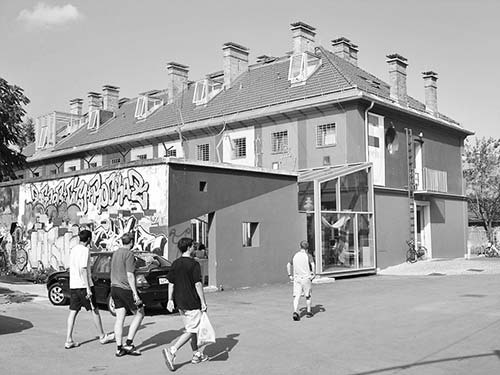
At this crossroads of cultures (and cuisines), Italian and French flavors are just as “local” as meat-and-starch Slovenian food. This cosmopolitan city also dabbles in other cuisines; you’ll find Thai, Indian, Chinese, Mexican, and more. Most places seem to offer a similar menu of Slovenian/Mediterranean fare with international flourishes. To locate these restaurants, see the map on here.
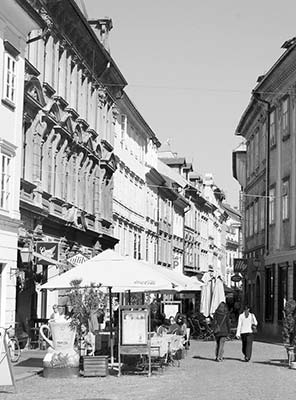
Lunch Deals: Ljubljana has many of the best restaurants in this book. However, they tend to be quite expensive. To stretch your budget, make a point to have your main meal at lunch, when most of Ljubljana’s top eateries serve a high-quality three-course meal (starter, main, dessert) at a very affordable price—usually around €10, not including drinks. You won’t have much choice (they may only have one or two options each day), but the quality is high and the value is outstanding. Some places offer these deals only on weekdays. After a big lunch, you can have a light dinner—picnic, burek, pizza, sandwich...or just gelato. Places I recommend that offer these lunch deals include Pri Vitezu, DaBuDa, Valvas’or, Julija, Marley & Me, Pri Škofu, Manna, and the restaurant at the top of The Skyscraper (I’ve noted “lunch special” where applicable below).
(See “Ljubljana Hotels & Restaurants” map, here.)
$$$$ Gostilna As (“Ace”), tucked into a courtyard just off Prešeren Square, offers fish lovers the best blowout in town. It’s dressy, pricey, and pretentious (the service is deliberate, and waiters ignore the menu and recommend what’s fresh). Everything is specially prepared each day and beautifully presented. It’s loosely based on the Slow Food model: Servings are small, and you’re expected to take your time and order two or three courses. The dining room is old-fashioned and a bit stuffy, but in good weather, their rooftop terrace is gorgeous (mostly fish and Italian dishes, daily 12:00-24:00, reservations smart, Čopova 5A, or enter courtyard with As sign near image of Julija on Wolfova, tel. 01/425-8822, www.gostilnaas.si). For cheaper food and drinks from the same kitchen, eat at the attached $$$ As Aperitivo, a much livelier, more casual spot. You’ll sit in the leafy courtyard or the winter garden, with big windows that stay open in the summer (salads, sandwiches, pastas, and main courses, food served daily 12:00-24:00, longer hours for drinks, good gelato counter inside). The courtyard also has a couple of other fun eateries—and, in the summer only, live music.
$$ Ribca (“Fish”) hides under the first stretch of market colonnade near the Triple Bridge. This is your best bet for a relatively quick and cheap riverside lunch. Choose between the two straightforward menus: grilled fillets or fried small fish. With the fragrant fish market right next door, you know it’s fresh. If you just want to enjoy sitting along the river below the bustling market, this is also a fine spot for a coffee or beer (Mon 8:00-16:00, Tue-Sat 8:00-21:00, Sun 11:00-18:00, tel. 01/425-1544).
$$$$ Pri Vitezu is well-respected for its seasonal menu of classic Mediterranean dishes. It sits along the newly spiffed-up Breg embankment, just beyond Cobblers’ Bridge; sit out on the pedestrian mall or in the Old World-elegant interior. Although a bit pretentious and quite expensive at dinner, this place is especially worthwhile for its good-value lunch special (Mon-Sat 11:00-23:00, closed Sun; shorter hours in winter and closed Sat-Sun; Breg 18-20, tel. 01/426-6058, www.privitezu.si).
$$ Friday Street Food: On good-weather Fridays from spring through fall, Ljubljana's outdoor market hosts the Odprta Kuhna ("Open Kitchen")—a sprawling al fresco food court where the country's newest and best chefs gather to showcase their creations. For the people of Ljubljana, this is both a culinary event and a social one. Foodies make this a priority (mid-March-mid-Oct Fri 10:00-21:00, until 23:00 in summer, can be canceled in bad weather, in the heart of the outdoor market zone—in front of the cathedral—at Pogačarjev trg, www.odprtakuhna.si).
Traditional Slovenian Food: Because Slovenes head into the countryside when they want traditional fare, Ljubljana isn’t the best place to find authentic Slovenian grub. But if you’d like to try some, your best budget bet may be $ Klobasarna, listed below. For a more formal sit-down meal, head for $$$ Gostilna na Gradu, in the castle courtyard high above town—if you don’t mind going up to the castle to get it (the handy funicular costs €4 round-trip). Run by a well-respected chef, it serves up a seasonal menu of traditional flavors with modern flair. The portions are small, but the prices are surprisingly affordable. Choose between the dull vaulted interior, the glassed-in arcade, or the outdoor tables. Reservations are recommended before you make the trip up here (Mon-Sat 10:00-24:00—food served until 22:00, Sun 9:00-18:00—food served until 17:00, Grajska Planota 1, mobile 031-301-777, www.nagradu.si).
Asian Fusion: $$ DaBuDa is the best spot in Ljubljana for Asian cuisine, featuring a well-described menu of good Thai dishes (salads, curries, wok meals, and noodles) in a very mod, dark-wood, split-level setting frequented by hip young professionals (lunch special, daily 12:00-23:00, also a few outdoor tables, between Congress Square and Square of the Republic at Šubičeva 1A, tel. 01/425-3060).
Fast and Cheap: $ Klobasarna is a budget foodie option specializing in kranjska klobasa—traditional Carniolan sausage, from the Slovenian uplands. The menu is simple—one wiener or two, extra for jota (hearty turnip stew)—and delicious. They also serve the Slovenian dumplings called štruklji (Mon-Sat 10:00-23:00, Sun 10:00-15:00, Ciril-Metodov trg 15, mobile 051-605-017). $ Paninoteka, with wonderful outdoor seating overlooking Cobblers’ Bridge and fine interior seating, has affordable and tasty sandwiches; their full menu is good, but much more expensive (daily 9:00-22:00, Jurčičev trg 3, mobile 040-349-329). Burek, the typical Balkan phyllo-dough snack, can be picked up at street stands around town. Most are open 24 hours and charge about €2-3 for a hearty portion. An easy choice is $ Nobel Burek, next to Miklošičeva cesta 30; but many locals prefer $ Olimpija Burek, around the corner at Pražakova 14 (across from the post office).
Pizzerias: $$ Pizzeria Foculus, tucked in a boring alleyway a few blocks up from the river, has a loyal local following, a happening atmosphere, an innovative leafy interior, a few outdoor tables, and Ljubljana’s best pizza (over 50 types, daily 11:00-24:00, just off French Revolution Square across the street from Plečnik’s National and University Library at Gregorčičeva 3, tel. 01/251-5643). $$ Ljubljanski Dvor enjoys the most convenient and scenic location of any pizzeria in town. On a sunny summer day, the outdoor riverside terrace is unbeatable; I’d skip the dull interior and the pricier pasta restaurant higher up (Mon-Sat 10:00-24:00, Sun 12:00-24:00, 50 yards from Cobblers’ Bridge at Dvorni trg 1, tel. 01/251-6555). Ljubljanski Dvor also has a handy, cheap $ takeout window (go around back to the walk-up window on Congress Square). Enjoy a slice at one of their outdoor tables facing Congress Square, or get it to go and munch it along the river.
(See “Ljubljana Hotels & Restaurants” map, here.)
The main drag through the Old Town (which starts at the Town Hall and changes names as it goes: Mestni trg, then Stari trg, then Gornji trg) is lined with inviting eateries. Tables clutter the cobbled pedestrian street. If you’re at a loss for where to eat in town, stroll here to survey your options, then pick your favorite menu and ambience. As many restaurants along here are uniformly good, no one place really has the edge.
Several popular options cluster in one particularly atmospheric stretch; all except Romeo offer a similar menu of Mediterranean-Slovenian cuisine and wonderful outdoor seating: $$$$ Valvas’or, the upscale option, has a dressy dining room and a posh gold color scheme (weekday lunch deal, Mon-Sat 12:00-22:00, closed Sun, Stari trg 7, tel. 01/425-0455). $$$ Julija features homey country-Slovenian decor inside (lunch deals, daily 12:00-22:00, Stari trg 9, tel. 01/425-6463). $$ Romeo, across the street, is a lowbrow bar serving unexceptional Mexican food...but the name sure is clever (get it? “Romeo and Julija”). And $$$ Marley & Me comes with a warm welcome from Matej (weekday lunch specials, daily 11:00-23:00, Stari Trg 9, tel. 08/380-6610). I’ve also enjoyed a great salad lunch at the nearby $$ Čajna Hiša teahouse (described later, under “Coffee, Tea, and Treats.”)
(See “Ljubljana Hotels & Restaurants” map, here.)
The Krakovo district—just south of the city center, where garden patches nearly outnumber simple homes—is a pleasant area to wander. It’s also home to two tasty restaurants. If the nearby Jože Plečnik House is open during your visit, you could combine your visit there with a meal at one of these options.
$$ Pri Škofu (“By the Bishop”) is a laid-back, leafy place with appealing outdoor seating, a nondescript modern interior, and a focus on freshness, serving international cuisine with a Slovenian flair. This hidden gem is deliciously memorable; reserve ahead (creative soups, cheap lunches, homemade desserts, Mon-Fri 10:00-24:00—but may be closed on Mon, Sat-Sun 12:00-24:00, Rečna 8, tel. 01/426-4508).
$$$$ Manna, with artfully presented, seasonal Slovenian-Mediterranean fusion cuisine, sits along the pleasant Gradaščica canal. The interior is pure Secession—the Gustav Klimt-era, early 20th-century, gold-accented Viennese style that was so influential in Ljubljana. I prefer the more artistic, café-like downstairs to the stuffy upstairs dining room, but the seating out front is hard to beat on a nice day. This is another fine splurge that you can enjoy affordably through their lunch special (Mon-Sat 11:00-24:00, Sun 11:00-21:00, Eipprova 1A, tel. 05/992-2308, www.restaurant-manna.com).
(See “Ljubljana Hotels & Restaurants” map, here.)
Riverfront Cafés: Enjoying a coffee, beer, or ice-cream cone along the Ljubljanica River embankment (between the Triple and Cobblers’ bridges) is Ljubljana’s single best experience—worth ▲▲▲. Tables spill into the street, and some of the best-dressed, best-looking students on the planet happily fill them day and night. (A common question from first-time visitors to Ljubljana: “Doesn’t anybody here have a job?”) This is some of the top people-watching in Europe. Just explore and find the spot with the breezy ambience you like best. When ordering, the easiest choice is a bela kava (white coffee)—a caffè latte.
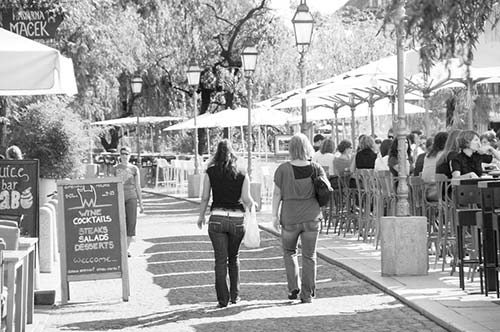
Teahouse: If coffee’s not your cup of tea, go a block inland to the teahouse $$ Čajna Hiša. They serve about 50 different types of tea, light food (including great salads and sandwiches), and desserts (Mon-Fri 8:00-22:00, Sat 8:00-15:00, Sun 10:00-14:00, on the atmospheric main drag in the Old Town a few steps from Cobblers’ Bridge at Stari trg 3, tel. 01/421-2444). They also have an attached tea shop, Cha (described on here).
Cakes: Zvezda Kavarna, a trendy, central place at the bottom of Congress Square, is a local favorite for cakes, pastries, and ice cream. A nostalgic favorite here—once popular in communist times, and recently reintroduced to great acclaim—is the emona kocka (Emona cube), a layer cake with nuts, cake, and chocolate (Mon-Sat 7:00-23:00, Sun 10:00-20:00, a block up from Prešeren Square at Wolfova 14, tel. 01/421-9090). Their Deli, one door toward Prešeren Square, has takeaway coffee and smoothies, a wide variety of cakes to go, and some of the most decadent ice cream in town (same hours). And their Bistro, around the corner facing Congress Square, has a full menu.
Chocolates and Ice Cream: Rustika is a local chain that sells tasty homemade chocolates, cookies (including one kind with four different types of chocolate), and a wide variety of unusual and delicious artisanal ice cream flavors. The menu changes from day to day, but highlights can include balsamic vinegar with vanilla or strawberry, very dark chocolate, Kanada (with maple syrup and walnuts), and Greek yogurt with honey and nuts. The handiest location is about an eight-minute walk from Prešeren Square, and comes with a delightful stroll along colorful Trubarjeva cesta (ice cream available summer only, Mon-Fri 8:00-19:00, Sat 9:00-13:00, closed Sun, Trubarjeva cesta 44, mobile 059-935-730). Don’t confuse this sweet shop with the Rustika gift shop.
More Ice Cream: Ljubljana is known for its Italian gelato-style ice cream. You’ll see fine options all along the Ljubljanica River embankment, but many places serve ice cream only in summer. Romantica, just up the steps from the river, is the foodies’ choice, with creative and delicious artisanal flavors (just uphill from Ljubljanksi Dvor pizzeria at Dvorni trg 1). Fétiche Patisserie, along the riverfront café embankment, is another good choice, with some unusual, pungent, Asian-themed flavors. Other favorites include Rustika and Zvezda Kavarna (both described earlier).
As Slovenia’s transportation hub, Ljubljana is well-connected to both domestic and international destinations. When checking schedules, be aware of city name variations: In Slovene, Vienna is “Dunaj,” Budapest is “Budimpešt,” and Venice is “Benétke.”
To reach Istria (just south of Slovenia) by public transportation, you have two relatively straightforward options: In summer, direct buses depart Ljubljana for Rovinj each day (3-4/day late June-Aug, 1/day Sept, none Oct-late June). From late June through late September, there’s also a train connection to Pula (1/day, change in Hrpelje-Kozina); once in Pula, you can connect by bus to other Istrian destinations. On off-season weekends, you might have to get creative (try connecting through Rijeka).
From Ljubljana by Train to: Lesce-Bled (roughly hourly, 40-60 minutes—but bus is better because it goes right to Bled town center), Postojna (nearly hourly, 1 hour), Divača (close to Škocjan Caves and Lipica, nearly hourly, 1.75 hours), Sežana (close to Lipica, nearly hourly, 2 hours), Piran (direct bus is better—see next; otherwise allow 4 hours, train to Koper, 4/day, 2.5 hours; then bus to Piran, 7/day, 30 minutes), Maribor (hourly, 2-3 hours, most with a change in Zidani Most), Ptuj (1/day direct, 2.5 hours, more with change in Pragersko and sometimes additional change in Zidani Most), Zagreb (4/day direct, 2.5 hours), Rijeka (2/day direct, 3 hours), Pula (1/day late June-late Sept, 5 hours, change in Hrpelje-Kozina), Split (1/day, 9 hours, change in Zagreb), Vienna (that’s Dunaj in Slovene, 1/day direct, 6 hours; otherwise 7/day with change in Villach, Maribor, or Graz, 7 hours), Budapest (that’s Budimpešta in Slovene; 1/day direct, 8 hours, other connections possible with 1-2 changes, 9 hours, no convenient night train), Venice (called Benétke in Slovene; fastest by bus—see next; otherwise 2/day with a change in Villach, 6 hours), Salzburg (2/day direct, 4-5 hours, an additional 2/day possible with change in Villach), Munich (2/day direct, 6 hours, including 1 night train; otherwise change in Salzburg). Train info: Toll tel. 01/291-3332, www.slo-zeleznice.si.
The bus station is a low-profile building in front of the train station. Buses depart from the numbered stalls in the middle of the street. For any bus, you have to buy tickets at the bus station ticket windows or at the automated e-kart kiosk (pay with credit card or cash), not from the driver. For bus information, pick up one of the blue phones inside the station to be connected to a helpful English-speaking operator. Bus info: www.ap-ljubljana.si, toll tel. 1991 (€1.50/call), from the US call 011-386-1-234-4600.
By Bus to: Bled (Mon-Sat hourly—usually at the top of each hour, fewer on Sun, 1.25 hours), Postojna (at least hourly, 1 hour), Divača (close to Škocjan Caves and Lipica, about every 2-3 hours, 1.5 hours), Piran (5/day Mon-Fri, 2/day Sat, 4/day Sun, 2.5 hours), over the Vršič Pass to Bovec (2/day July-Aug at 6:30 and 15:00, June and Sept Sat-Sun only at 6:30, 4.25 hours to Bovec, none Oct-May), Kobarid (1/day in July-Aug over Vršič Pass, 5 hours; otherwise faster but less scenic via Idrija, 3.5 hours), Rijeka (1/day in summer, none off-season, 2.5 hours), Zagreb (10/day, less on weekends, 2.5 hours). To reach Croatia’s Istria—specifically Rovinj—the bus is your best option (3-4/day late June-Aug, 1/day Sept, none Oct-late June, 4-5.5 hours, buses also stop in Piran and Poreč; off-season: 2/week to Poreč or Pula and change there to Rovinj, generally Mon and Fri, departs at 16:00). DRD runs a handy direct bus from Ljubljana to the Venice-Mestre train station (on the mainland, with easy and frequent train connections to the island; 1/day each way, departs at 8:15, 3.75 hours).
If bus and train schedules don’t quite get you where you need to go, GoOpti—a company with an innovative business model for shared minibus transfers—can be a convenient and inexpensive option for somewhat flexible travelers. First, go to www.goopti.com and select your destination, date, and preferred time of arrival or departure. Then, 24 hours before departure, you’ll get an update of the specific pickup time, based on the needs of other passengers. Prices can flex dramatically, but it’s quite affordable (for example, an advance nonrefundable purchase from Ljubljana could be €17 to Piran, €20 to Venice, or €22 to Zagreb; for the best price, book two months ahead). For a few euros extra, they can pick you up at your hotel rather than the train or bus station. To lock in a specific time, you can pay extra for a “VIP” transfer (“VIP flex” is similar, but refundable).
GoOpti reaches destinations throughout Slovenia (including Ljubljana, the airport, Lake Bled, Lake Bohinj, Bovec in the Julian Alps, towns in the Karst such as Postojna and Sežana, and Piran and other Slovenian coastal destinations), but it’s also handy for farther-flung international destinations—such as Venice or its airport, Trieste, various Austrian cities (Vienna, Salzburg, Klagenfurt, etc.), and Croatian cities such as Zagreb and Pula.
Slovenia’s only airport (airport code: LJU) is 14 miles north of Ljubljana, about halfway to Bled. Confusingly, the airport goes by three names: Ljubljana Airport (the international version); Brnik (for the town that it’s near); and Jože Pučnik Airport (a politician for whom it was controversially renamed in 2007). Most flights are operated by Slovenia’s national airline, Adria Airways (www.adria-airways.com), but additional flights are run by EasyJet (www.easyjet.com), Wizz Air (www.wizzair.com), and various national carriers (Air France, Turkish Airlines, Finnair, and so on). The airport is small and manageable. Morning flights tend to cluster around the same time frame (between 6:45 and 7:30); as the airport doesn’t open until 5:00, there’s no need to show up before then. If you need to kill time here, follow signs (around to the left as you exit the terminal) to Razgledna Terasa and Terasa Avionček and ride the elevator up to the rooftop terrace with a café (daily 9:00-19:00). Here you can sip a coffee while you watch planes land and take off. Airport info: tel. 04/206-1000, www.lju-airport.si.
Getting Between Downtown Ljubljana and the Airport: Two kinds of buses connect the airport with Ljubljana’s bus station: public bus #28 (to the right as you exit the airport; Mon-Fri hourly until 20:00, only 7/day Sat-Sun, 45 minutes, €4.10), and a minibus (to the left as you exit the airport, scheduled to depart after various arriving flights—look for schedule posted near bus stop). Two different companies run the minibus transfers, which take about 30 minutes and cost €9 to downtown: Markun (mobile 041-792-865, www.prevozi-markun.com) and Marko Nowotny (mobile 040-771-771, www.mnj.si). I’d take whichever one is departing first. For a transfer to the airport, your hotel or any TI can make arrangements with one of these companies a day or so in advance (same price)—or you can try GoOpti, described earlier. Unfortunately, certain evening arrivals don’t coordinate well with either the bus or the minibus, so you might have to wait a while or take a pricey taxi (figure €25-35 to the airport if you call a reputable company, but more like €42 from the airport—since you have to use the pricey taxi stand out front).
To Lake Bled: For tips on going from the airport directly to Lake Bled, see here.
Airport Alternatives: Ljubljana’s airport—the only one in the country—charges high taxes and fees, and has limited connections to some European destinations. To save money (or to avoid a layover), many Slovenes fly in and out of relatively nearby airports in neighboring countries: Zagreb (2-hour drive from Ljubljana, see here); Venice (3-hour drive from Ljubljana); Trieste (2-hour drive from Ljubljana); and Klagenfurt/Kärnten (especially for those going to Lake Bled, from which it's a 2-hour drive). To get between these airports and your Slovenian destination, consider GoOpti, described earlier; this is typically cheaper than a taxi and more convenient than a bus or train connection.